Please send all Checks and Money orders to :
Dave Taylor P.O. Box 87 Sylvania, OH 43560
419-842-1863
Click Here to E-mail Us!
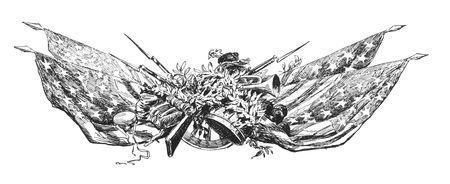
12 09

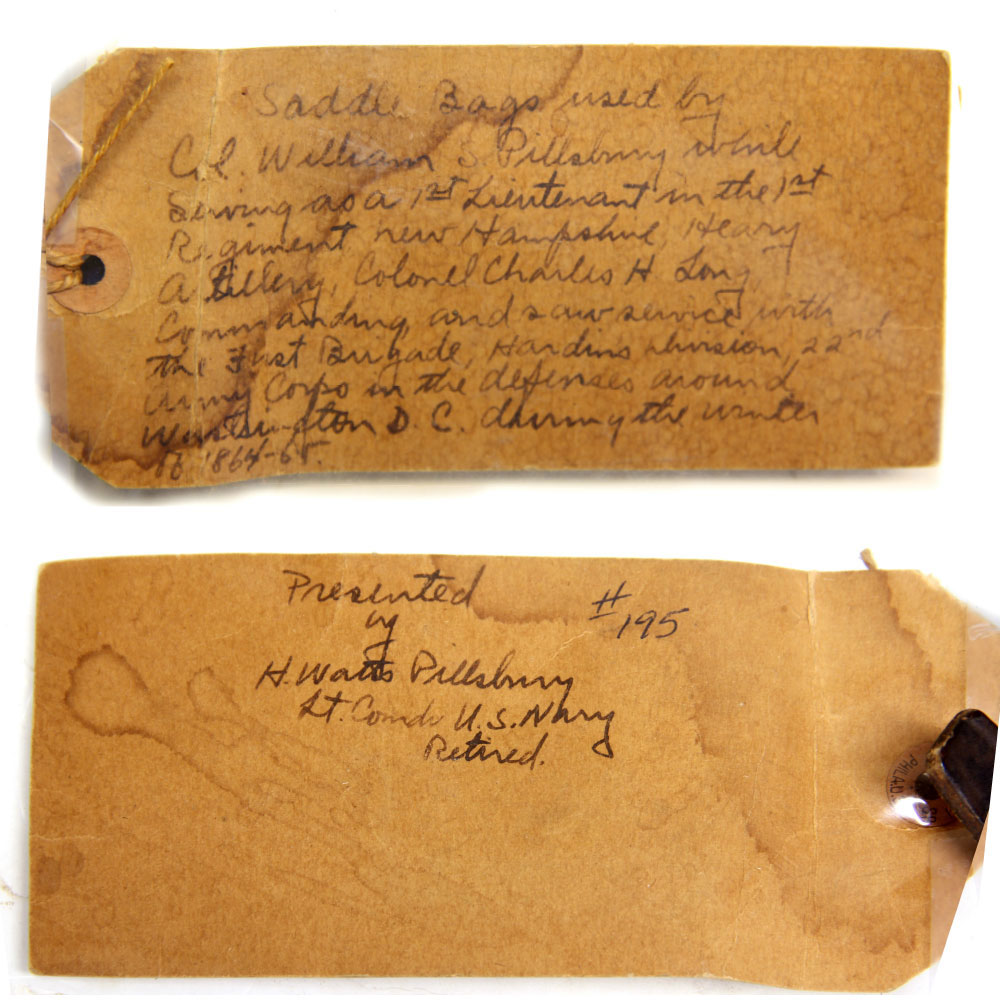
12-09-01 – Best Set of Saddle Bags I’ve Had in YEARS!
Extremely nice pair of identified m1859 McClellan pattern saddle bags! These would make a great addition to a cavalry display or an officer’s layout. These bags are complete and in very nice solid condition with all the tie-down straps that are often missing even from good examples. These come with a dead-real old ink tag from a veterans’ post or historical society reading:
“Saddle bags used by Col. William S. Pillsbury while serving as a 1st Lieutenant in the 1st Regiment New Hampshire Heavy Artillery, Col. Charles H. Long Commanding, and saw service with the First Brigade Hardins Division 22nd Army corps in the defenses around Washington D.C. during the winter of 1864-65.”
And on the other side:
“Presented by H. Watts Pillsbury Lt. Comdr. U.S. Navy Retired.”
William Stoughton Pillsbury served in three regiments during the war. Coming from an abolitionist family in Londonderry, NH, he spent some time in Kansas in the 1850s as part of an abolitionist family, he returned to Londonderry, NH, and ran a shoe store. When the war began he enlisted at age 28 on 9/14/1861 at Londonderry as a 1st Lieutenant, and on 9/18/1861 was commissioned into Co. I, 4th NH Infantry. While with the regiment at Annapolis, MD, he was injured and had to resign on 10/20/1861. After a few months recovery he again joined the service and on 7/3/1862 he was commissioned as a First Lieutenant in Co. A, 9th NH Infantry. He acted as a recruiting officer and then joined the regiment in the field and was at South Mountain and Antietam. One biography states that, “his quick thinking saved his company from mass casualties at the Battle of South Mountain,” but provides no details, so there may be an interesting story to be discovered. At Antietam the regiment was engaged in the fighting around Burnside’s Bridge and was credited with being the third regiment across it. Soon after the battle he was taken ill with pneumonia and again had to resign his commission, on 10/9/62. Pillsbury’s last service relates most closely to the saddlebags. He was again commissioned a lieutenant on 9/7/64, this time in Co. D, 1st NH Heavy Artillery. This was a unit stationed in the fortifications around Washington, Pillsbury’s company serving in forts on the south side of the Potomac. He served with them until muster out on 6/15/65. After the war he ran a successful factory. A biography states that while with the 1st NHHA he served as “Ordnance Officer,” which implies staff duty requiring a mount. It seems likely that it was in connection with this duty that he acquired this pair of regulation saddlebags.
This is a great set of CW regulation issue bags with a wonderful tag whether you like identified material, officer’s equipment, New Hamshire items, or cavalry gear….
$1,950.00 SOLD
Call us @ 419-842-1863
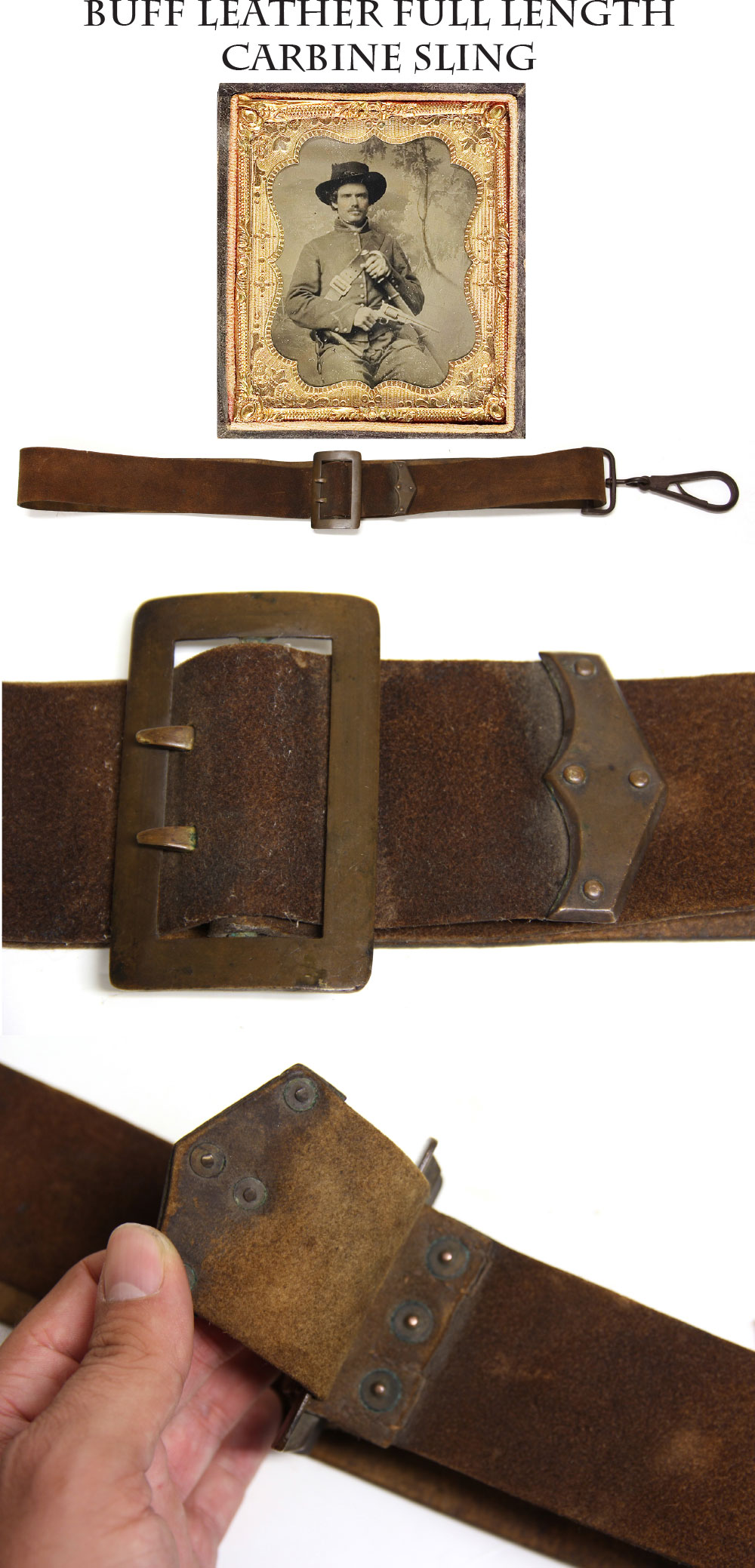
12-09-02 – Buff Leather Full Length Carbine Sling:
Fresh from a New Jersey attic is this “Holy Grail” cavalry accoutrement… A regulation FULL LENGTH cavalry carbine sling in BUFF leather. Harness leather examples in full length are plenty scarce. Buff leather examples are downright rare. Excellent condition in all respects. Beautiful undisturbed age patina on the buckle and tip, both secured with their original stitching and/or rivets. Full length, unaltered since the Civil War, attractive brown color. A top notch example of one of the scarcest of cavalry accoutrements. You will hunt long and hard before you find another…
$2,250.00
SOLD
Call us @ 419-842-1863

12-09-03 – Early War Union Army Infantryman’s Belt and Buckle:
Regulation issue harness leather belt with early style standing brass adjuster. Regulation US oval buckle with arrow hooks and prong. Leather is supple with good life, showing only expected wear.
$395.00 SOLD
Call us @ 419-842-1863

12-09-04 – Regulation Cavalry Saber Belt:
Harness leather regulation Union Army enlisted cavalryman’s saber belt in overall VG condition. Complete with both saber hangers and the “over the shoulder” support strap. Has the proper rectangular eagle pattern sword belt plate with applied German silver wreath, with rich deep uncleaned age patina. Buckle is bench marked 573, keeper is marked 370. Fits perfectly. Overall VG condition just showing honest and expected age. Priced as friendly as I can get it …
$795.00 SOLD
PS Just in — mint unissued buff leather cavalry saber belt complete with buckle. Call for details…
$1,950.00 SOLD
Call us @ 419-842-1863
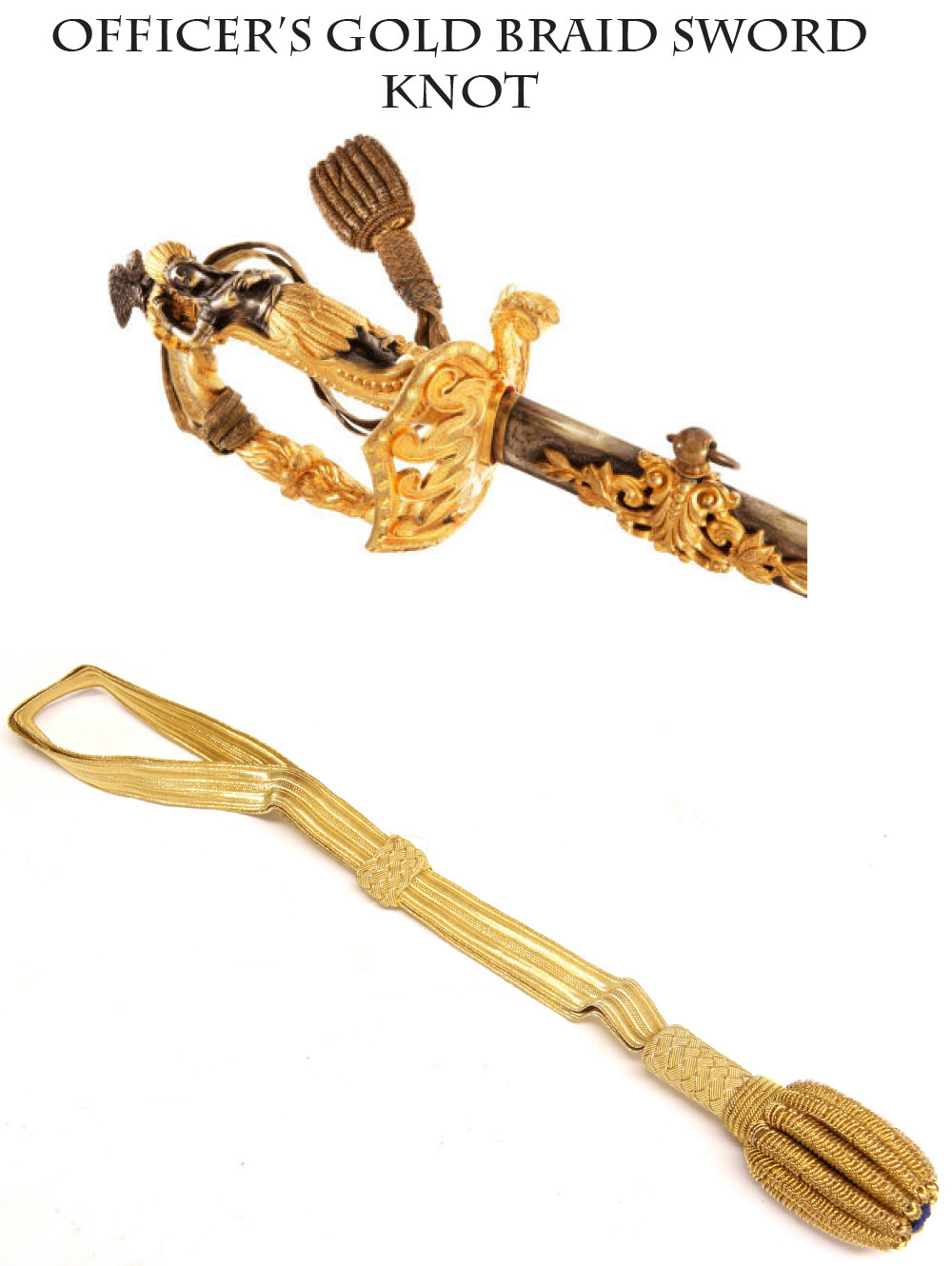
12-09-05 – Near Mint condition officer’s gold braid sword knot
just as seen in the Schuyler, Hartley & Graham catalog, etc. These are hard to find on the loose when you need one. Flat tassel end with a turk’s head knot and sliding gold braid keeper as well. This will look great on a strong condition officer’s sword of any type.
$150.00 SOLD
Call us @ 419-842-1863

12-09-06 – CDV Nice from-life vignetted bust view of Confederate John C. Breckinridge
, politician and CS general. Toronto, Canada, photographer backmark. Probably taken during his sojourn abroad after the Civil War when he feared he might be tried for treason and fled to Cuba, Britain, and Canada. Breckinridge (1821-1875) was a significant figure in the country’s descent into civil war. A Kentucky politician, he served as Vice President under Buchanan and ran unsuccessfully for President in 1860 as a pro-slavery candidate. He was, however, elected as a Senator from Kentucky and served until October, 1861, when it was clear Kentucky would remain in the Union and he went south to join the Confederacy, for a time commanding the Kentucky “Orphan Brigade,” and reaching the rank of Major General. He fought at Shiloh, Stones River, Chickamauga, and other engagements in the west (and spending a lot time at odds with Braxton Bragg) before coming east, taking over Confederate forces in the Shenandoah Valley, commanding troops at the Battle of New Market, fighting with the Army of Northern Virginia at Cold Harbor and with Early on his raid toward Washington. Toward the end of the war Breckinridge combined his political and military talents to serve as the last Confederate Secretary of War, from February to May, 1865. When Breckinridge left the Senate to go south he was formally expelled and declared a traitor. Fearing prosecution, he remained abroad until 1869 when he was granted amnesty and returned to the practice of law in Kentucky until his death in 1875. A very significant figure militarily and politically…. And a darn rare subject to find in a “from life” photograph…
$500.00 SOLD
Call us @ 419-842-1863


12-09-07 – ID’ed Officer’s Binoculars with Carrying Case
An impressive set of identified officer’s binoculars with their carrying case and strap, the officer’s name, rank and hometown gilt embossed on the cover: “Capt. E. F. Smith / Lebanon, N.H.” There are lots of “period” binoculars around, but very few can be specifically connected with the Civil War, let alone a specific officer. Elias F. Smith was from Lebanon New Hampshire and 26 years-old when he enlisted in the 16th NHV on 9/20/62 and was commissioned Captain of Co. A on 11/18/62. The 16th NH was a nine-month regiment that was shipped south to New Orleans and served with the 19th Army Corps in the campaign and siege of Port Hudson. Although reporting only one death by enemy action the regiment was quite active on campaign and even supplied sharpshooters to some gunboats. It was also devastated by disease from its service: a regimental historian records an astonishing 23 percent death rate from disease and sickness acquired while campaigning.
Smith mustered out with the regiment on 8/20/63, but about a year later enlisted again in one of the first six companies formed for the 18th NH, being commissioned Captain of Co. B 18th NH on 9/20/64. These six companies were sent to City Point, VA, and assigned to Benham’s Engineer Brigade on Oct. 4. They served there and at Bermuda Hundred until being moved up to Petersburg and assigned to the 9th Army Corps. At Petersburg they were involved in trench warfare during the siege and in the fighting at Fort Stedman, which was Lee’s last attempt to break through Grant’s lines in late March. They received their tenth company just as the war ended, which enabled their Colonel, the well-known Thomas Livermore of the 5th NH, to finally muster in at that rank. While stationed in Washington in May, the regiment did guard duty during the trial of the Lincoln conspirators. Smith mustered out 6/10/65. The binocular case is solid, with some scuffing and a bit of shrinkage. The hinges on the lid, and the base show some minor repairs done by a previous owner. The repairs in conjunction with the shrinkage prevents the cover of the case from closing over the binoculars without risking damage to the hinges. They are best displayed outside the case. The shoulder strap is full-length. The gilt embossed “I.D.” is absolutely spectacular. The glasses themselves are a very interesting pattern. They have the leather covering on the tubes, though it is missing from the extending sun shades. One the rear top of the eyepieces is a flat brass bar to keep the eyepieces in alignment while focusing, something rarely seen on the more generic binoculars “of the period.” In fact this is the first such pair I have owned with the brass bar.
A nice identified piece of officer’s equipment that actually saw use in the field as part of his service in the 16th or 18th New Hampshire, or both… Again, real Civil War identified binoculars are among the scarcest of antiques. These are great and display like a million bucks.
$1,250.00 SOLD
Call us @ 419-842-1863

12-09-08 – A real Confederate cap box that hits all the right notes
: Cast lead finial, crude square flap, and wide one-piece belt loop… classic Johnny Reb — “CSA all the way”. It even retains its fleece, which is rarely found in a Rebel cap box due to the hard service they saw. Heck, it’s hard to find rebel cap boxes period… much less ones with original fleece. Confederate infantry was known as the best light infantry in the world. They may have gotten rid of everything else that would slow them down, but a rifle, cartridge box and cap box were their essential tools. This one shows absolutely typical CS construction and is in very good++ shape- just minor scuffing to the edges and the separate sewn latch tab has been expertly repaired and resewn by us. Otherwise untouched. The finial is in place (many of these are found torn out) and the wide belt loop is solid with just slight crackling a small half-moon tear on the left edge. This is just “Johnny” all the way- One of the best
$1,150.00 SOLD
Call us @ 419-842-1863

12-09-09 – Beautiful clear horizontal quarter plate
outdoor view tintype of a proud horse owner or perhaps he is a horse seller. The man stands in a dirt street behind his probably new acquisition and looks at the camera over Rienzi’s neck (or perhaps it is Traveller’s ?), holding the head still by the bridle and resting his other hand on the long mane. Behind them is a fenced house, what is probably a barn or stable with what seems to be a watering trough streetside, and the roofed porch of another, perhaps commercial building to the right. This is a nice crisp view that really makes you feel part of nineteenth century America when you look at it closely. Sort of like stepping back in time. Housed in a mat, frame, and glass.
$165.00 SOLD
Call us @ 419-842-1863

12-09-10 – Sixth Plate Tintype Likely Confederate artilleryman
with a bowie knife in his belt as well. This fellow just stopped at the barber for a square cut on his way to the photographer’s studio for this half-length seated view portrait. He looks squarely at the camera with his jaw set, wearing a gray frock or jacket with brass buttons. The photographer has tinted the piping on the collar and down the front in a delicate red for artillery. Best of all, he has stuck a cutlery handled Bowie knife in his waist belt. Buckle is hard to make out. I want to see a “CS” but using Adobe I have to say I believe it is a captured “US” oval (shown reversed of course due to the tintype process producing a mirror image.) The outline of the original mat is visible, which was removed to show more detail in the image. Housed in a full leatherette case.
$450.00 SOLD
Call us @ 419-842-1863
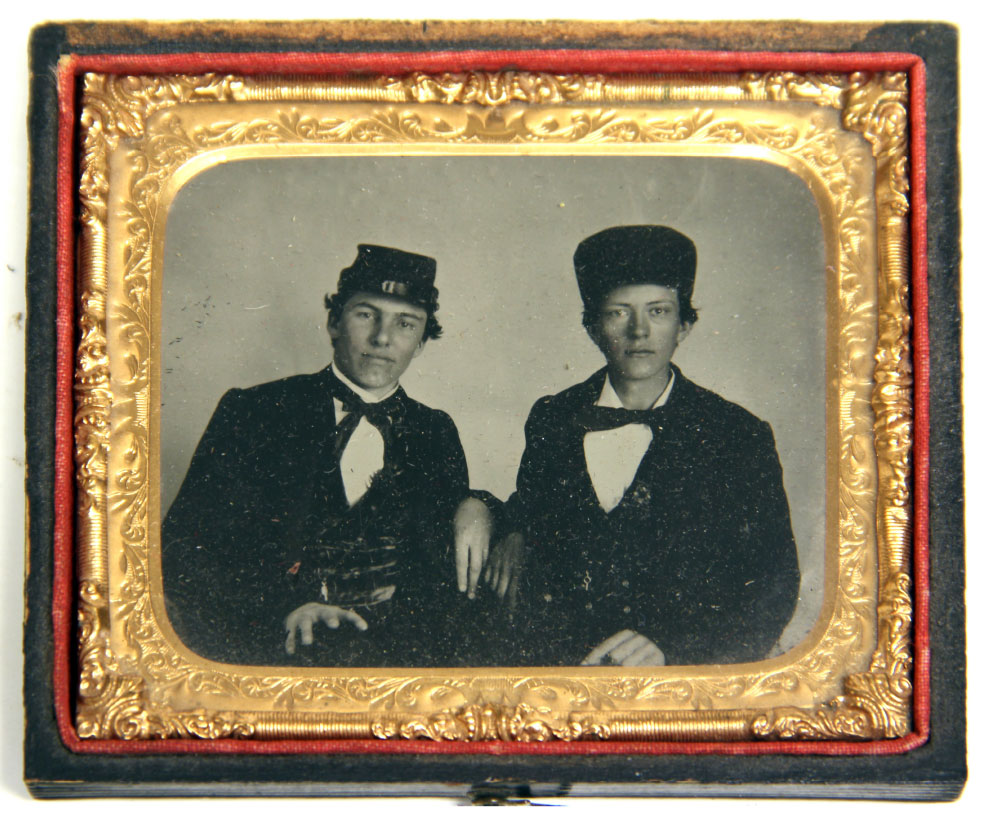
12-09-11 – School chums parting for the war?
A nice horizontal format sixth plate tintype of two young men seated together. The fellow on the right stares directly into the camera to memorialize the event. His chum on the left looks a little less certain- wearing a civilian coat, vest and tie, he sports a military forage cap, frequently one of the first things issued to a new recruit early in the war when uniforms were being delivered piecemeal to the depots of rendezvous for new regiments. In contrast to his buddy, who seems to lean forward into the camera, he settles backward and to the side somewhat and his expression suggests something on the order of “what am I getting myself into?”… probably a question many a young man asked himself after the patriotic speeches had faded and reality was settling in. A very evocative photograph circa 1861 housed in full leatherette case with separated hinge.
$175.00 SOLD
Call us @ 419-842-1863
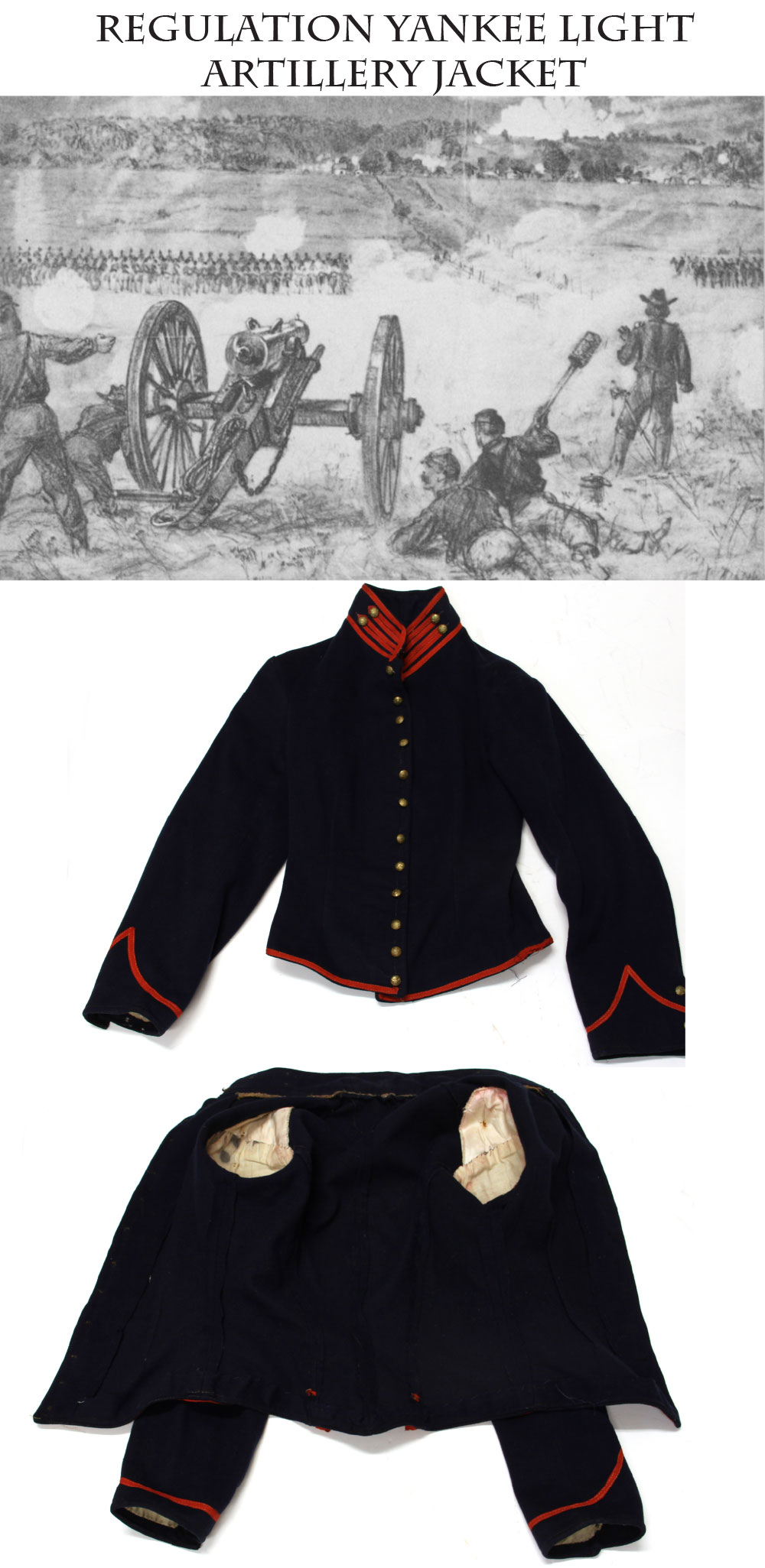
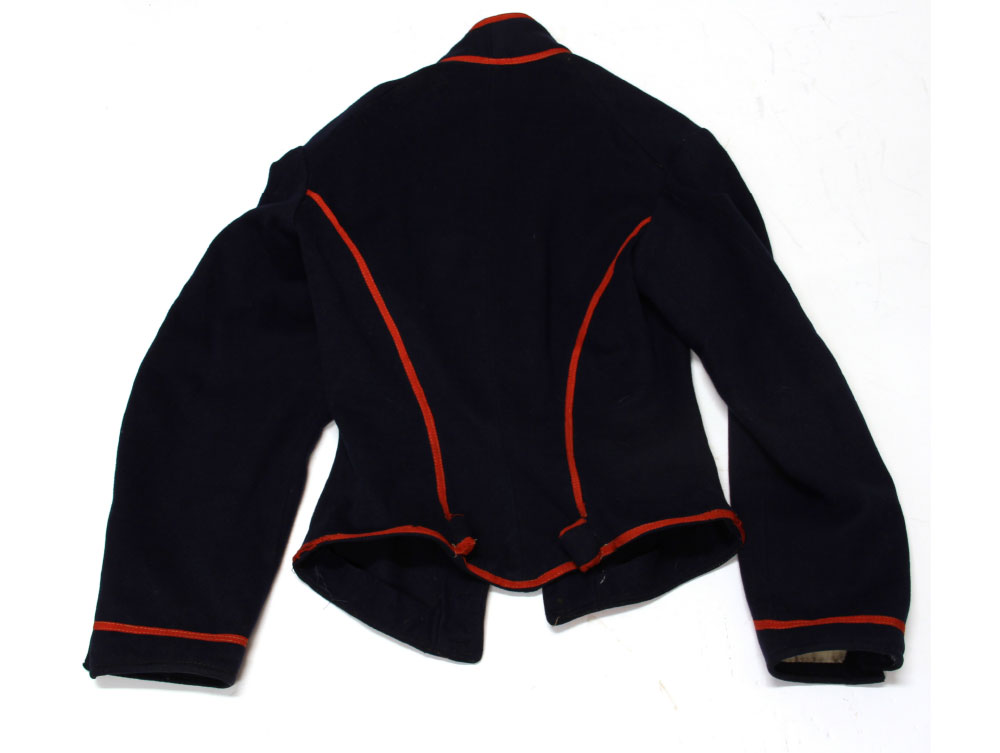
12-09-12 – Regulation Yankee light artillery jacket:
A Civil War general once remarked that with Confederate infantry and Yankee artillery he could “whip the world.” Here is a memento of that famous Yankee Artillery service- the 1855 pattern shell jacket trimmed in red on the collar, cuffs, front edge and back seams as per regulation throughout the Civil War. All front, collar, and cuff buttons are in place and correct. All the scarlet trim is still in place as well. This is a nice solid example that retains the padded bolsters on the rear waist that supported the saber belt. Sleeve linings in place, a little stitching repair at the top of each. Body lining was removed long ago. A little seam closing inside the collar would be in order, but otherwise excellent condition. Perfect for display on a mannequin or to lay flat in a glass case. Try and find another priced this fairly.
$1,450.00 SOLD
Call us @ 419-842-1863


12-09-13 – Nice Colt Model 1860 Army Revolver:
.44 Caliber, six shot. The most recognizable Civil War pistol, and next to a cavalry saber, the most typical cavalry arm, well regarded and carried by both northern and southern (when they could get them) troopers. The metal is smokey steel (lightly cleaned a generation ago) mixed with some gray and dark spots. Very nice patina on the brass. A few light dings where someone was tapping out the wedge to release the cylinder, but otherwise very nice metal with very sharp markings. Strong cylinder scene with appropriate patent marks and the last four digits of the serial number. Good sharp slots, unbattered nipples, and unbuggered screws make this old war horse very desirable. Tight wood to metal fit at the grip edges, and the fine condition grips still show inspector cartouches near the bottom on both sides! All matching serial numbers including the wedge: 127909, which make this an 1863 production gun. Totally honest and a gun that definitely saw service in the Civil War. You will be proud to own this one…
$1,950.00 SOLD
Call us @ 419-842-1863

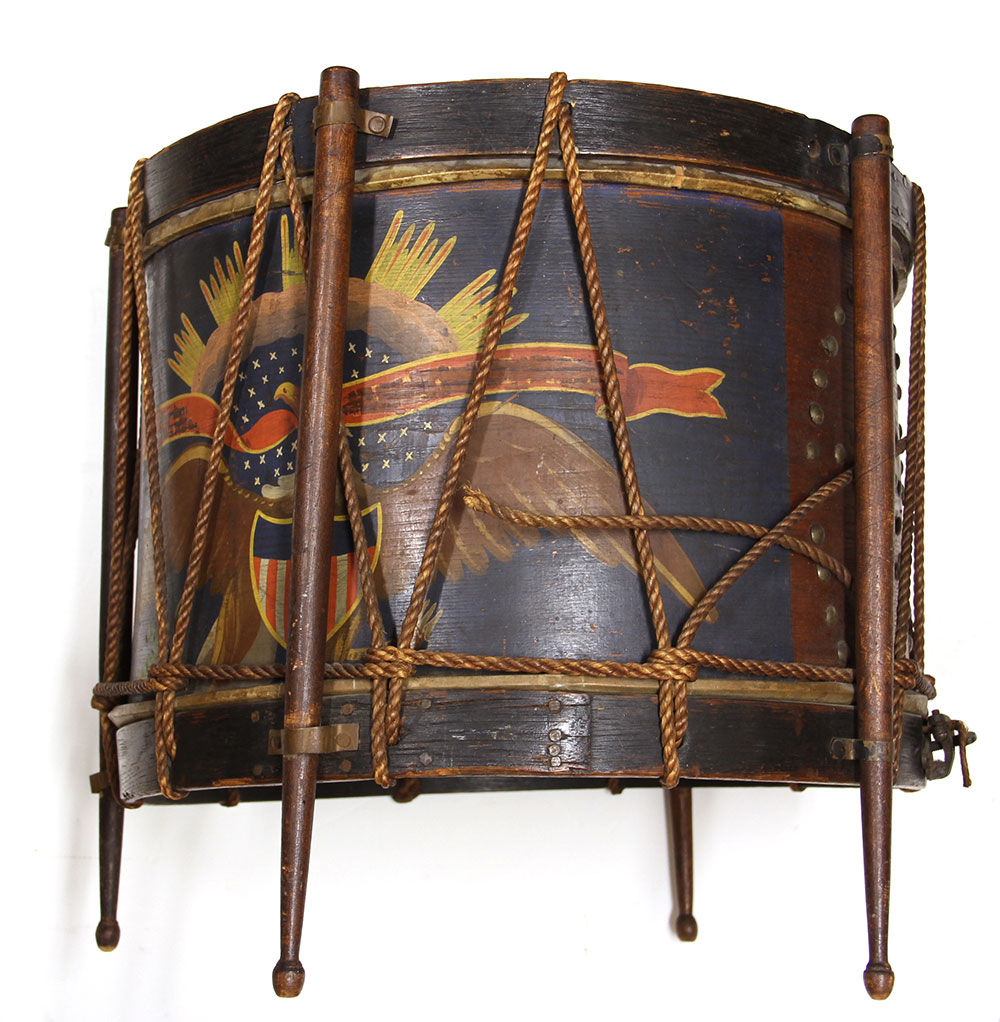
12-09-14 – Wonderful Folk Art Civil War Eagle Drum:
Fresh from a family in California is this regulation Government Contract Union Army Eagle Drum with drum sticks affixed for display. Measures roughly 16” dia x 13” tall in size… the bottom edge of the shell was shortened during its period of use to change the pitch. Excellent paint with no flaking and only minimal wear. The riband in the eagle’s mouth was over-painted, obscuring the regimental designation originally painted there. I presume this was done when the GAR post or museum added the drum sticks to it. The word “INFANTRY” can still be faintly seen on the viewer’s right hand side. Perhaps a competent art restorer could remove the over-paint and reveal the unit. Makes a superb display piece with the four drum sticks affixed to the rims forming a sort of “table” affair. Ropes are original but broken in places. No label remains. Very cool Civil War drum. Looks fabulous on display with other CW antiques as accents.
$3,250.00 … SOLD 4-17-13
Call us @ 419-842-1863

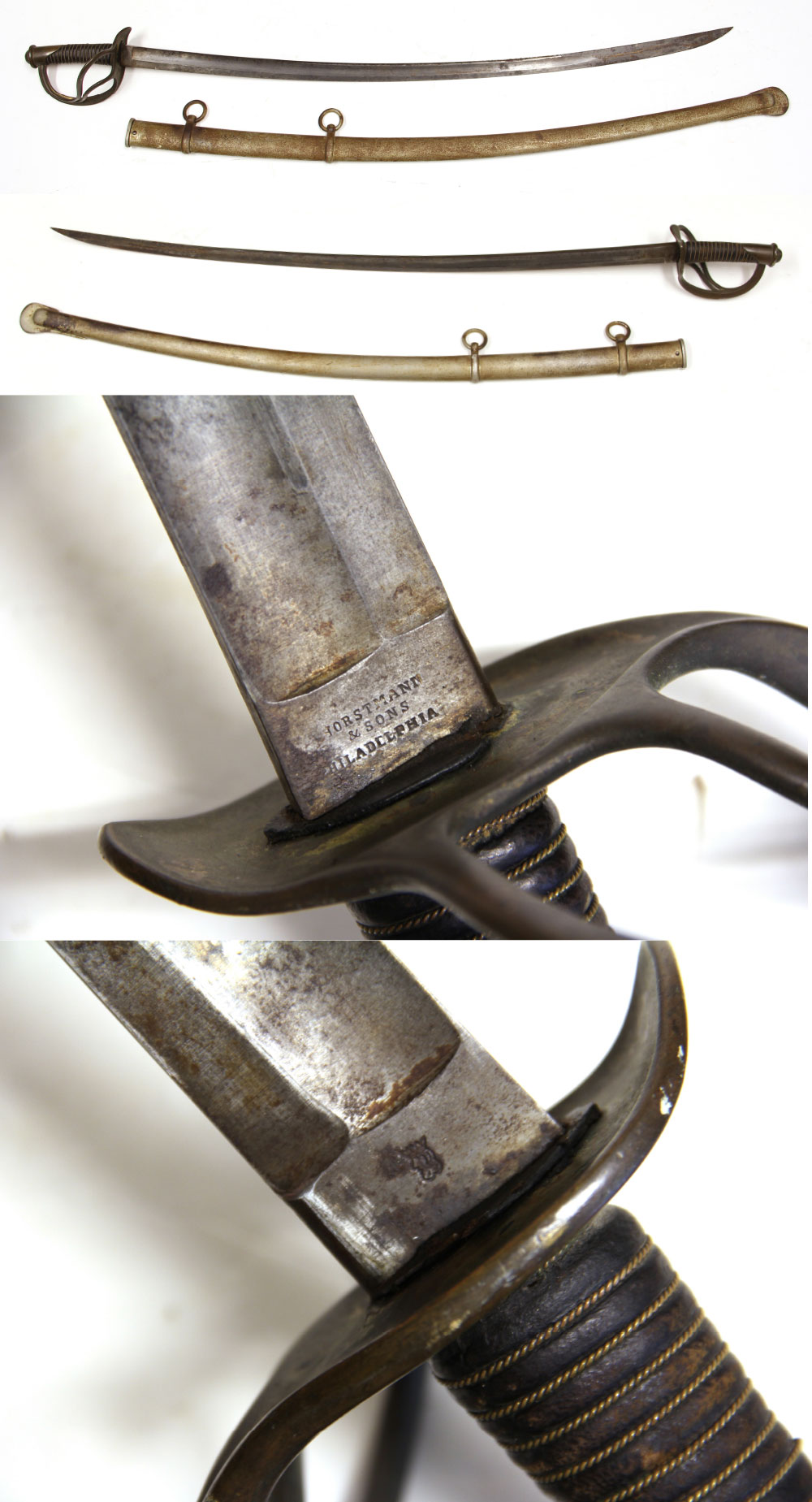
12-09-15 – Wonderful 14th Missouri Set! Ambrotype, Ladder Badge & Sword!
Fighting Guerrillas in Missouri and Indians in Kansas! Regimentally identified saber, ladder badge and photograph from the 14th Missouri Volunteer Cavalry. These pieces were sold to me from the family descendants but they did not know the name of the soldier who carried the saber. Luckily the regimental ladder badge was present to preserve the unit identification.
Names such as Quantrill, Clements, Younger, and James are familiar to students of the war and outlaws of the west. There were conflicts among regular forces from Wilson’s Creek in 1861 to Pilot Knob in 1864, but the most bitter and savage fighting took place between pro-Union and pro-Southern neighbors and it did not end with the surrender of the main armies.
The 14th Missouri Volunteer Cavalry was formed in the Fall of 1864, but it was formed from veterans of the Missouri State Militia who had been fighting roving bands of guerrillas and “bushwackers” since 1862. The regiment mustered in nine companies in April, 1865, and was posted in St. Louis and Springfield, but it was not restful duty as a report of a scout in May, 1865, from their Lt. Colonel makes clear:
I proceeded, in compliance with your instructions, on the 23d instant in direction of Duroc, via Belmont and Warsaw, scouting the country thoroughly along–to the Osage, and down the Osage to the mouth of Coal Camp Creek, and ascertained that there were no rebels in that section of the country north of the Osage. The band that crossed the railroad near Knobnoster on the 22d instant were all that I could obtain any reliable information of. At Warsaw and other points I learned that the above-named band committed horrid outrages, murdering some ten or twelve discharged soldiers and citizens in Hickory and Benton Counties. Not hearing reliable reports of other bands of guerrillas, I returned to camp at this place this p. m. at 5 o’clock. Men and horses in good condition.
After chasing bands of ex-Confederate partisans, the regiment was sent to Kansas later in the year to participate in operations against the Indians along the Santa Fe Trail, but fortunately for the men, when the expedition was abandoned they returned to Fort Leavenworth and were discharged in October, 1865.
Missouri units always had problems getting weapons. (Early the war Fremont got in trouble for his direct acquisition of arms from various dealers.) But this regiment is known to have had Starr carbines and model 1840 cavalry sabers, and the saber is a nice untouched 1840-pattern “wristbreaker” cavalry saber by Horstmann, who imported their swords from Germany and this one bears the “King’s Head” mark of the “Gebruder Weyersberg” on the ricasso opposite the firm name, “Horstmann & Sons / Philadelphia.” The sword is just as it was put away 150 years ago. The grip is nice, with all wire and the original leather in place. The blade shows an unmessed with patina of bright mixed with gray and some dark spots, no rust, pitting or edge nicks. The scabbard is the correct import scabbard with a screw at the mouth holding the throat piece. The metal was bright when put away and has acquired shallow salt and pepper rust spots overall.
The photo is a 9th Plate ambrotype. The dark backing to make it appear as a positive image has deteriorated so it now appears dark and shows up almost as a negative, but it shows a young soldier wearing fatigue cap, clasping the lapel of his blouse with one hand. The blouse is open, showing a white vest with military buttons beneath. There is no name, but the ladder badge identifies him as a member of Company A of the 14th Missouri Volunteer Cavalry, and I have to say that he bears more than a passing resemblance to William Bailey, a young soldier of that company, who is one of just two men from the regiment pictured on CWData. His service, though, is in no doubt. The veteran’s badge is a German silver ladder badge consisting of four bars with his company, regimental and state affiliation, and a nice smaller cavalry corps badge suspended from the bottom bar.
Western theatre material is scarce- it got used up and thrown away. I can think of ten eastern identified sabers off the top of my head, but hardly any from men struggling to keep Missouri in the Union. A wonderful historical grouping.
$1,395.00 SOLD
Call us @ 419-842-1863
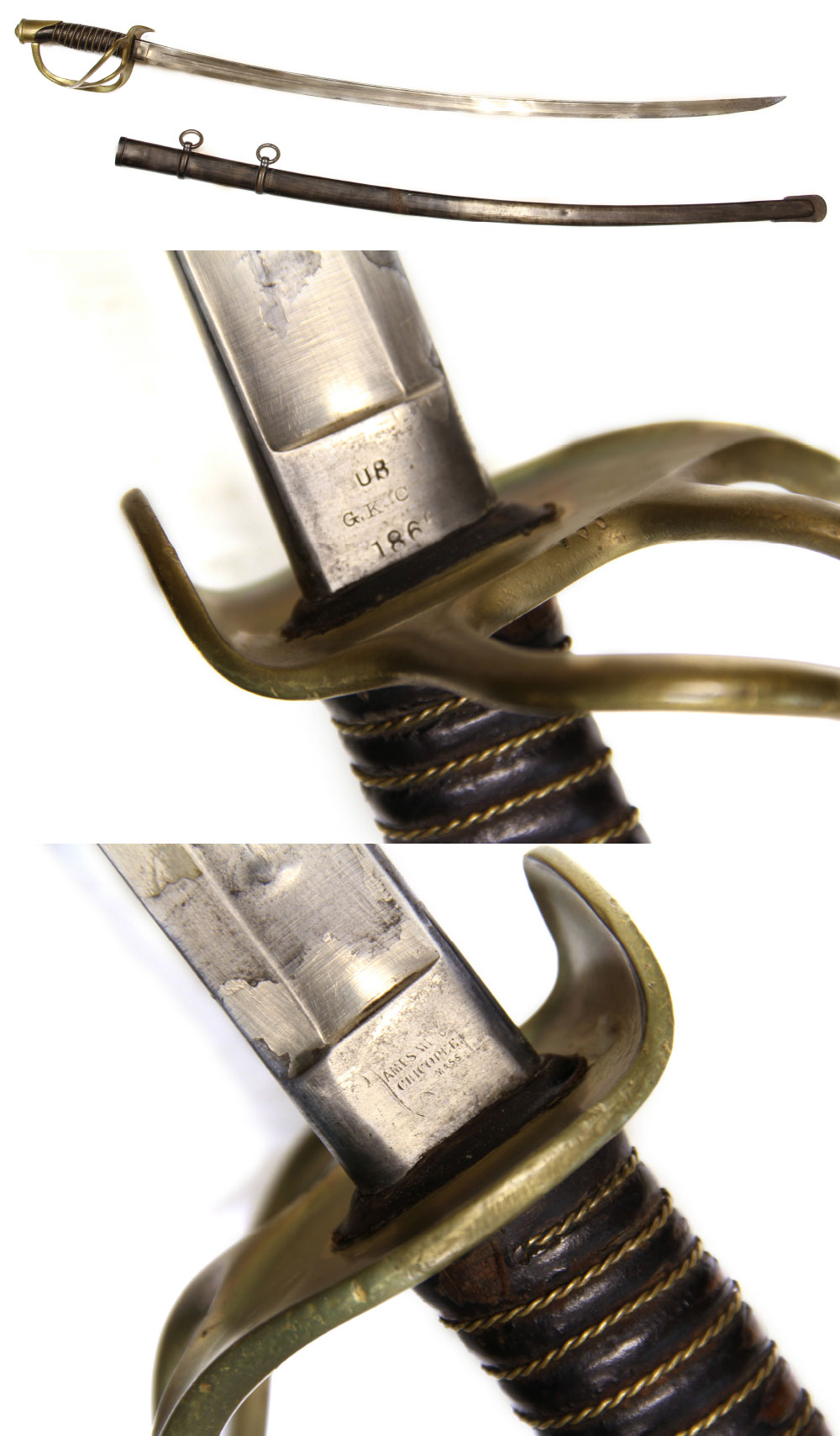
12-09-16 – Ames Light Cavalry Saber & later Scabbard:
Fine condition M1860 US Light Cavalry saber nicely marked by Ames Mfg. Co. Also bears date 186?, U.S., and inspectors mark “GKC”. Excellent grip wrap and wire. VG blade with remnants of early plating. Scabbard is the 1906 style with ring mounts closer together and screw securing the throat in place. Perfect for reenacting or display. A great bargain at
$395.00 SOLD
Call us @ 419-842-1863

12-09-17 – Wonderful Mexican War US Navy Officer’s Group including his sword, daguerreotype, and portrait with the very sword! Fresh from the family!
This super group also has his hat band, portraits of his ship and even a handbill for its launching, all preserved and documented by his son and passed down to his great-grandson.
Burritt Shepard was a member of an old and well connected family. I was fortunate to have a colleague contact me when he found this archive in a Virginia antique shop. We bought it instantly. Shepard enlisted in the navy and became a Midshipman 1 Feb. 1826; made Passed Midshipman 28 April 1832; and Lieutenant 8 March 1837; he resigned 22 June 1849. During his service he was on board the USS Lexington in the Mediterranean as a Midshipman and his journal from 1827-30 is preserved in Rutgers University library. In the early 1840s he was assigned to the newly launched USS Raritan and acted as Executive Officer during that ship’s participation in the blockade and landings on the Mexican coast during the war. He resigned in 1849 and raised a family. His grandson retained these mementos of his service and passed them on to the great grandson about 1920.
The object of greatest interest will be Shepard’s model 1841 US Navy Officer’s Sword. Regarded by many as the most beautiful of US regulation swords, this example has loads of original gilt on the hilt, still has its scabbard in very good condition, and bears a dead-real commemorative inscription on the inboard folding guard reading:
Lieutenant Burritt Shepard
U.S. Navy
Midshipman, 1826 Lieutenant, 1837
Resigned 1849
Executive Officer
Frigate “Raritan”
In Mexican War
When found there was a break and slight loss in the scabbard just above the drag. I had this professionally restored using a two inch section of identical original scabbard material. The repair is virtually undetectable.
Also present in this lot is a wonderful large portrait of Shepard in uniform holding this very sword!
Sword: The eagle head pommel, backstrap, and knucklebow retains loads of the original gilding, as do the acorn shaped quillons and the outboard fold down guard with the leaf and acorn design. The bone grip shows a bit of age shrinkage from the backstap and a longitudinal crack on either side near the bottom edge, but is solid. The half-blued blade is flat backed (these were produced both quill back and flat back) with much of the original blue which shows off the beautiful gilt floral designs: blade is etched with fouled anchor, circle of stars oak leaves and acorns. The blue has shaded into a charcoal tone where the maker’s name is dry etched at the ricasso: On the other side the blue is vivid, with some brown spots showing through.
The scabbard is excellent with the repair mentioned above. Lots of gilt remaining on the mounts: the upper mount with decorated stud as well as carrying ring, floral decorations and a circle of stars, fouled anchor on the middle mount with carrying ring, and drag bears leaves and acorns.
The sword is clearly shown in the uniformed portrait of Shepard. The large portrait is a delicate pastel work showing Shepard standing ¾ length, knees up, with this very sword clearly shown. The frame measures 31” x 28”. Typical 1840 hair style and big flowing necktie. Posed in his short blue cutaway double-breasted jacket with brass buttons on the front and horizontally across the cuff, with correct single epaulet of a Lieutenant, all proper for the undress uniform of 1841. He has white gloves, one off and held at his side while the other hand is gloved and resting on the pommel of this sword. The oak frame on this appears to date circa 1890. There is a very cool eagle on globe fixed to the top center of the frame. This looks dynamite displayed with the sword! Present is a fine sixth plate daguerreotype of Shepard that seems to have been taken about the same time as the original photo on which the portrait was based. The hairstyle looks the same and he wears the same outlandish bowtie. His coat seems also to be an undress jacket, though the end of the necktie flares out so that it not possible to see if he is wearing the epaulet. The Shepard family also preserved for us the 1841 regulation bullion band from his undress hat with a very nice, clear, period brown ink note pinned to it reading: “Cap–band belonging to Burritt Shepard – U.S.N. 1826 to 1849.”
Two images of the USS Raritan were also kept with the group. The first is a copy photo made by a Somerville, NJ, photographer of a lithograph made soon after the launching of the ship, showing it under sail and giving its date of launch, tonnage, armament, etc. This was inscribed by Burritt Shepard’s son when he passed the material to his grandson: “Presented by Robert Fitch Shepard to his grandson Robert Fitch Shepard Whitely, whose great grandfather, Lieutenant Burritt Shepard, U.S. Navy, was Executive office of the Raritan in the War with Mexico.”
Another copy of the same image was also framed together with a Victorian photographic copy of an earlier handbill advertising an excursion aboard the steamboat Trenton to witness the launch of the Frigate Raritan the next day. It gives times of departure, etc., and notes that they will take up a “favorable position near the Navy Yard, to afford to those on board a full view of the Launch.”
The USS Raritan was launched until 1843, one of the last sailing frigates of the US Navy. In 1844-45 the ship was in the South Atlantic, and then made part of the Home Squadron. Based in Florida, the ship helped blockade the Mexican coast and participate in landings at Point Isabel, Veracruz, Tuxpan, and Tabasco. The ship then returned to the Norfolk Navy Yard and was laid up briefly. After Shepard’s departure the ship was in the West Indies and eventually the Pacific. Having returned to Norfolk and being again laid up, the ship was destroyed at the beginning of the Civil War when Union forces had to evacuate Norfolk in 1861.
This is an outstanding American family archive, to have it is to be part of American history. I am proud to offer it, and you would be proud to have it on the wall….
$8,900.00
Call us @ 419-842-1863

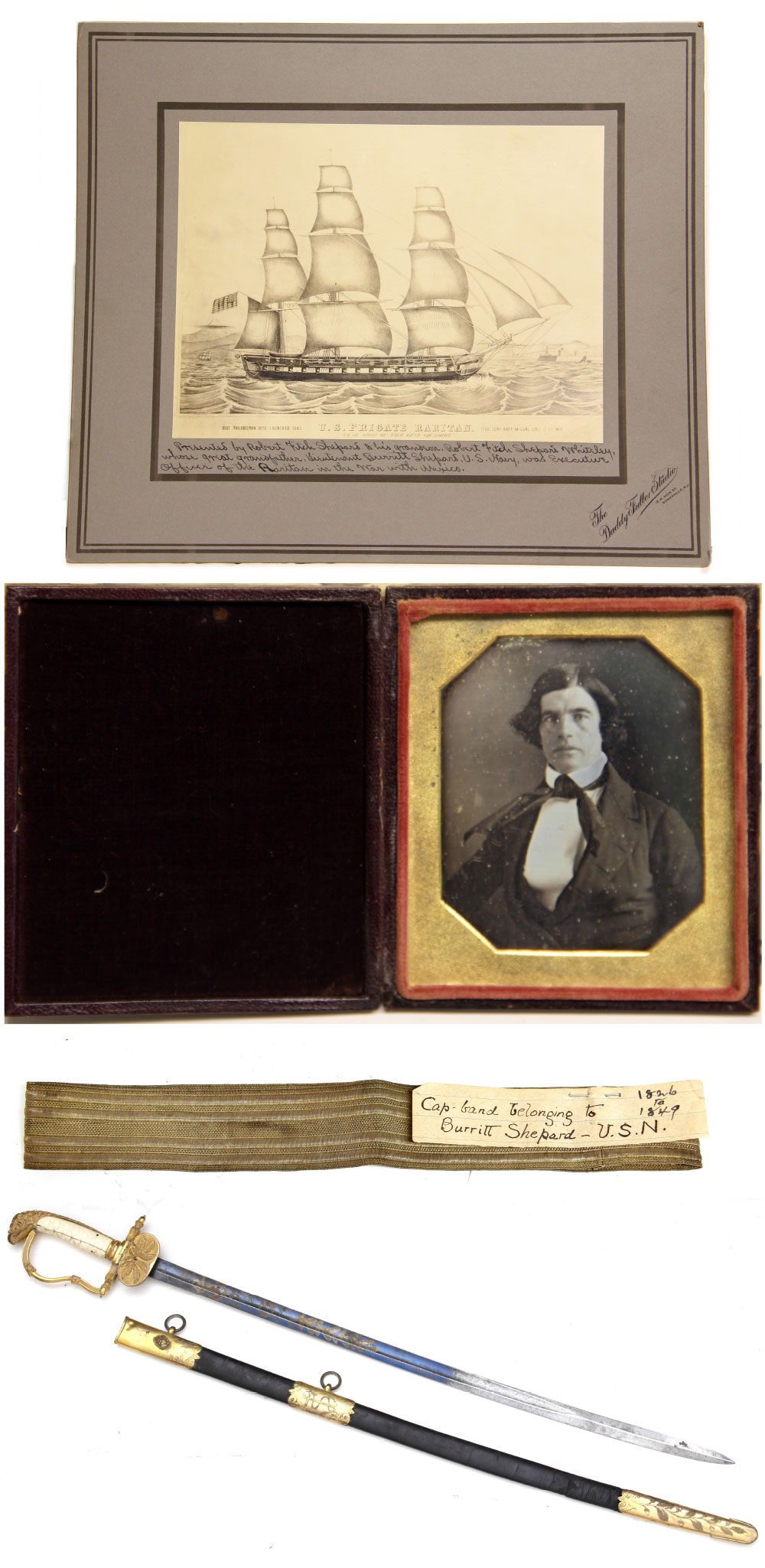
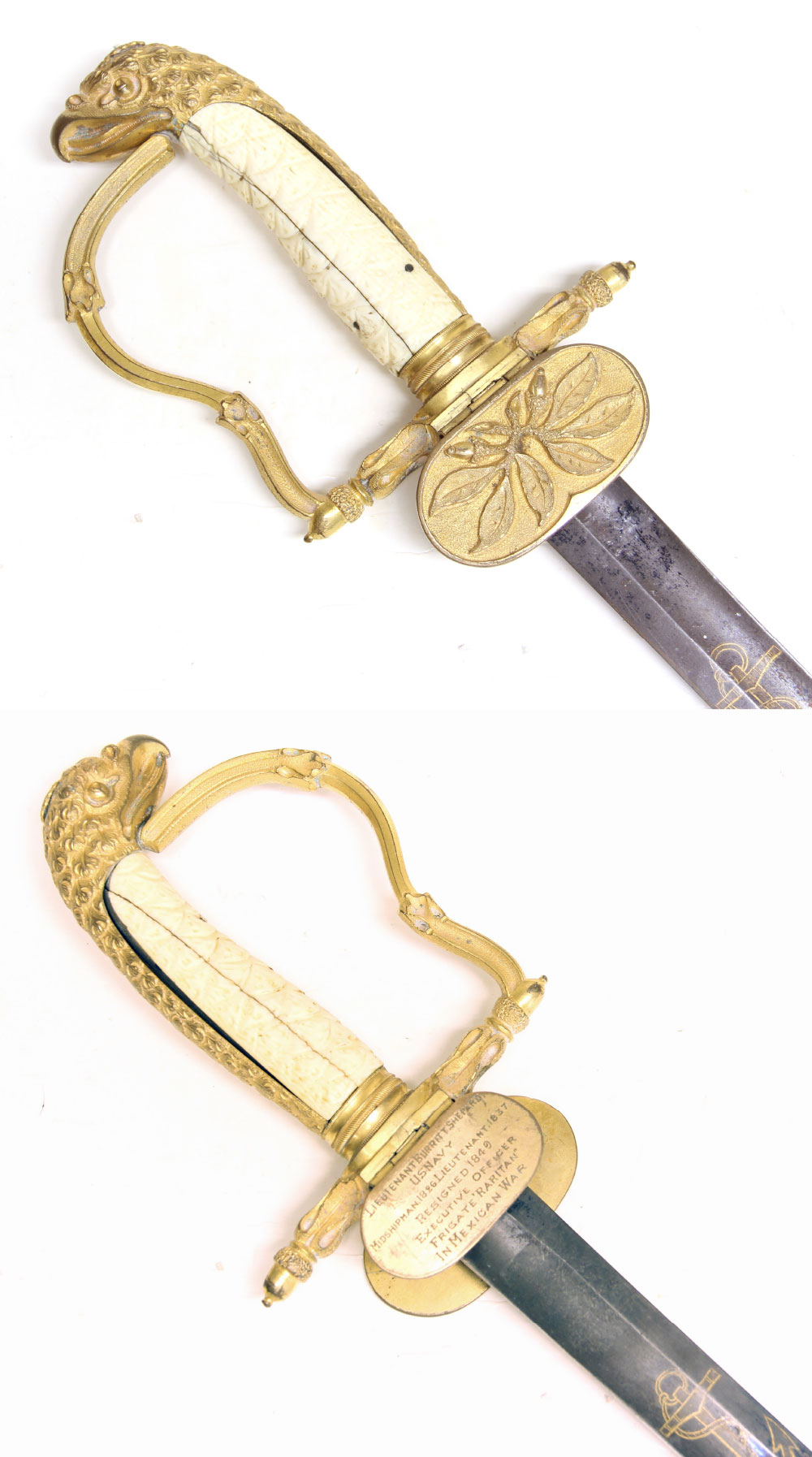
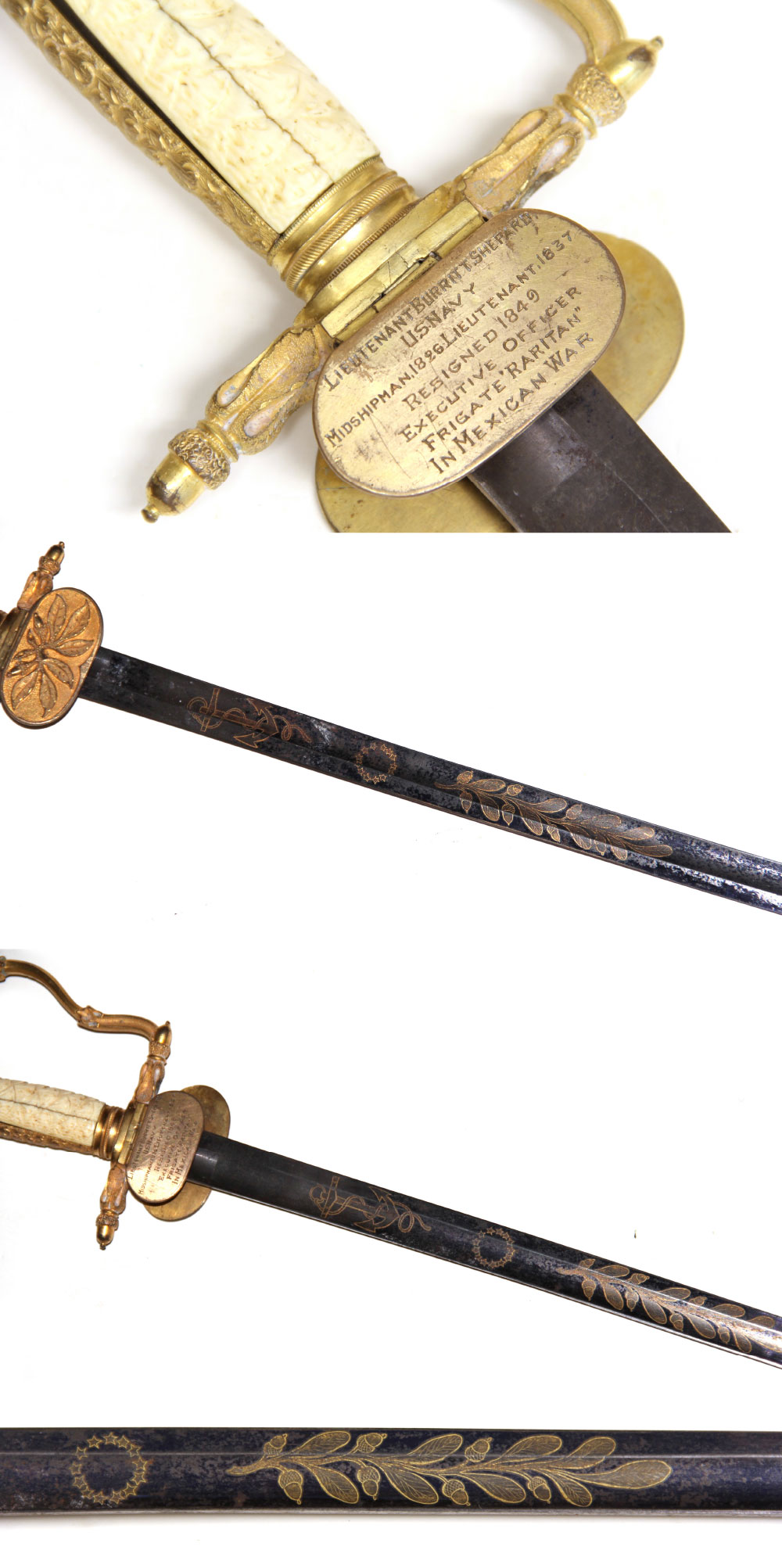
Call us @ 419-842-1863

12-09-18 – Nice Sharps Four-Barrel .22 Caliber Pepperbox Derringer:
Excellent wood grips with tight wood-to-metal fit. Brass frame with correct circular “C. Sharps & Co. / Philada. PA.” stamp on the left side and “C. Sharps Patent 1859” on the right. Both stamps are light on the bottom arc but sharp on the top. Steel is bright mixed with gray and some dark spots, no pitting or peppering. Brass has nice mellow patina. Serial number 7490 on the bottom of the grip. These guns were very popular as pocket guns for concealment and last ditch protection. The design let the four barrels remain stationary and rotated the firing pin! Good mechanism and bores. This would look great in a Civil War or early Western Display—soldiers and officers liked them when going into town—as did the western gambler…. All original and mechanically perfect.
$595.00 SOLD
Call us @ 419-842-1863

12-09-19 – “Allegheny Arsenal 1864” marked US Cavalry bit, complete with rosettes.
We generally see surplus artillery bits on the market, and unmarked (except inspector’s initials) surplus cavalry examples… so I am willing to walk over someone’s back to get a non-dug, dated, arsenal marked example, especially with a Civil War date. Stamped deeply into the steel is “ALLEGHENY ARSENAL 1864”… an extremely rare marking to find on a cavalry bit, and about as good as it gets. This 1863 pattern has the additional point of having its original brass US rosettes in place where many have been removed or never mounted. The high port is a Number 4. The rein rings are there and move freely. Uncleaned overall, some of the iron is crusty from lying around but not deeply corroded, the markings are clear and the brass rosettes have a nice patina. A barn find that surfaced last Saturday….
$375.00 SOLD
Call us @ 419-842-1863

12-09-20 – Gettysburg Confederate Dead at the Rose Woods:
Nice tonal quality stereo-card by Gettysburg photographer L. Mumper with his logo on left and right margins: “L. Mumper, Gettysburg, PA. / Views of the Battle Field of Gettysburg.” Mumper was selling views after the war to tourists and visiting veterans. Here he pirated the Gardner-O’Sullivan view of Confederate dead laid out for burial in the field above the Rose Woods. These men were killed in the heavy fighting around the Wheatfield on July 2 and had been laid out for burial by Confederate troops, but the area was retaken by Federal troops before they could be interred. Mumper decided to increase the salability of the view by adding a stamped title at the lower right reading “DEAD ON CULP’S HILL.” The fighting on that part of the battlefield had gotten a lot more attention in the battle’s aftermath and it made sense from a business point of view to give the public what it wanted. The same view was also marketed as showing the dead of the 24th Michigan of the Iron Brigade near McPherson’s Woods as tastes changed or maybe just for variety.
A strong image and an interesting one in terms of photographic history and the interpretation of the battlefield. Very good condition, good mount, period ink inventory number on reverse.
$350.00 SOLD
Call us @ 419-842-1863
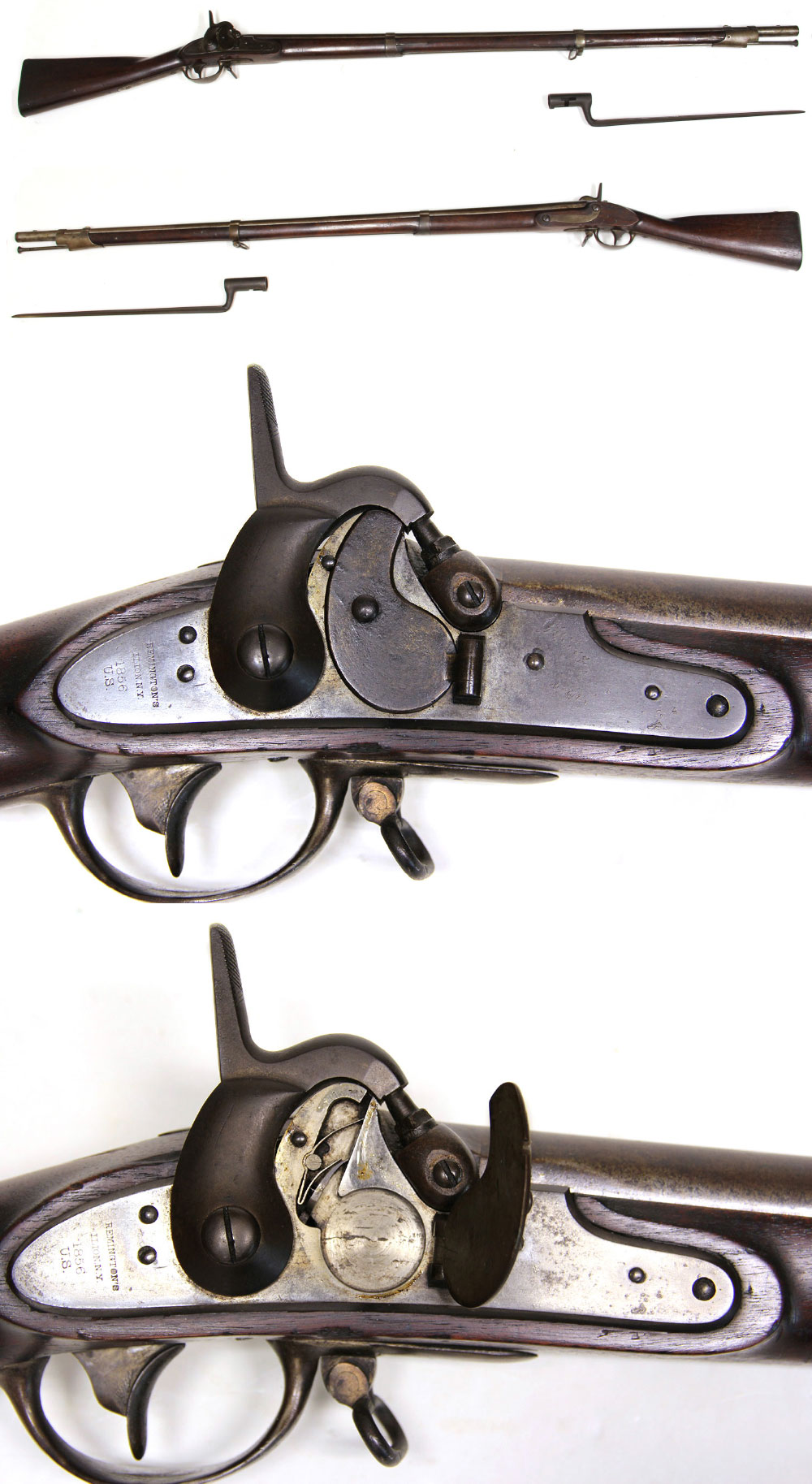
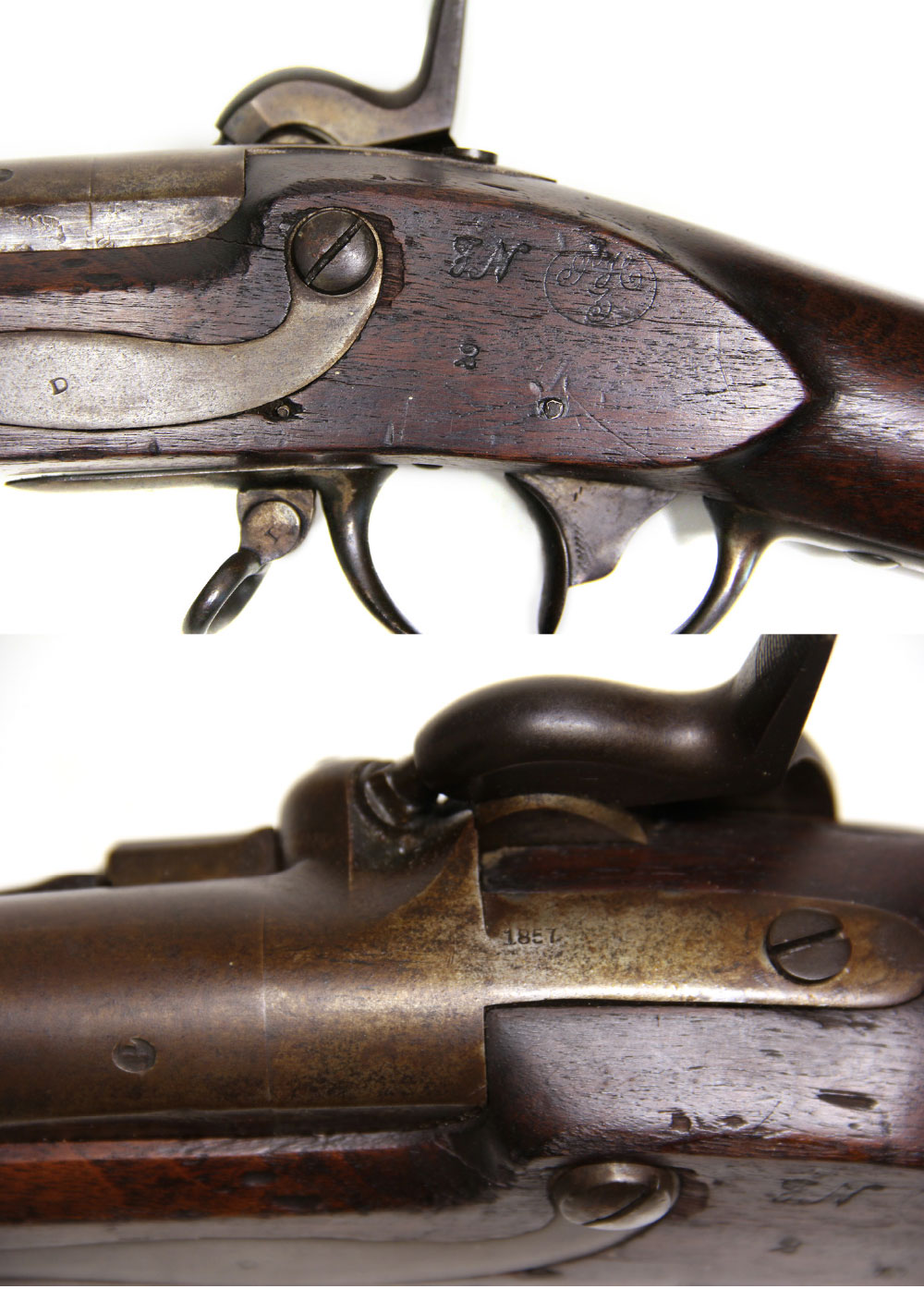
12-09-21 – Remington Maynard Tape Conversion M1816 Musket:
1856 Dated. Remington had a US contract in 1854 to supply breech pieces and Maynard style percussion locks to retro-fit 1816 pattern muskets at Frankford Arsenal. This one is a near “fine” condition example, complete with the original bayonet. These weapons were heavily used at the beginning of the Civil War. Nice clear “Remington’s / Ilion N.Y./ 1856/ U.S.” on the lock plate at rear, barrel proofs, and the inspectors cartouches and classification number stamps on the reverse. Sharp nipple, bolster and screws. Some traces of color on the lockplate, the primer door a tad darker with some light crustiness. Good stock, just a minor chip above the sideplate and on underside near the triggerguard… With bayonet $1595.00 Without bayonet
$1475.00 SOLD
Call us @ 419-842-1863
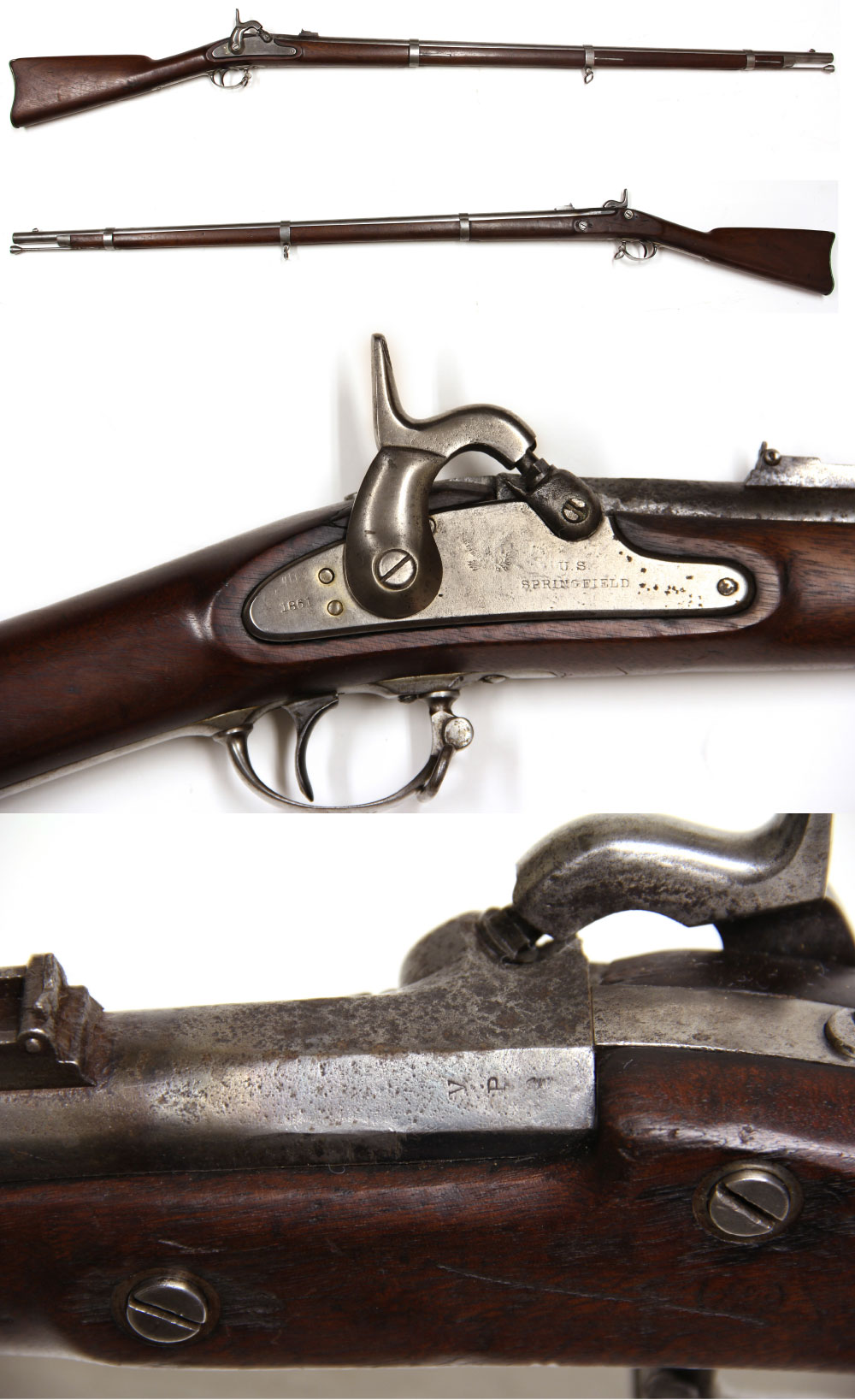
12-09-22 – 1861 Dated ’61 Pattern Springfield:
The first year of manufacture of this standard issue Yankee rifle. These have ALWAYS been sought after, but as a friend of mine says, they were “ridden hard and put away wet,” and finding one in any condition is a chore. This one was cleaned years ago but has begun to tone down again. Good legible 1861 date at the rear of the lockplate and an eagle and “U.S. / Springfield” forward of the hammer. The eagle is a bit light from corrosion from firing and the cleaning (the fulminate of mercury in the percussion caps is far more damaging to the metal at the breech than any powder is to the gun overall.) Some light peppering to the bolster, the nipple is pretty sharp and probably an old replacement. The rear sight is the correct and scarce Type-I as found on M1855 and early M1861 rifles and muskets. The long range leaf is missing. No visible inspector cartouche or barrel date due to wartime use. Barrel and bands nicely patinated. Rod is a reproduction and should be replaced. If you want the quintessential Union infantryman’s weapon this a very good example and still affordable… here you go…
$1,150.00 SOLD
Call us @ 419-842-1863
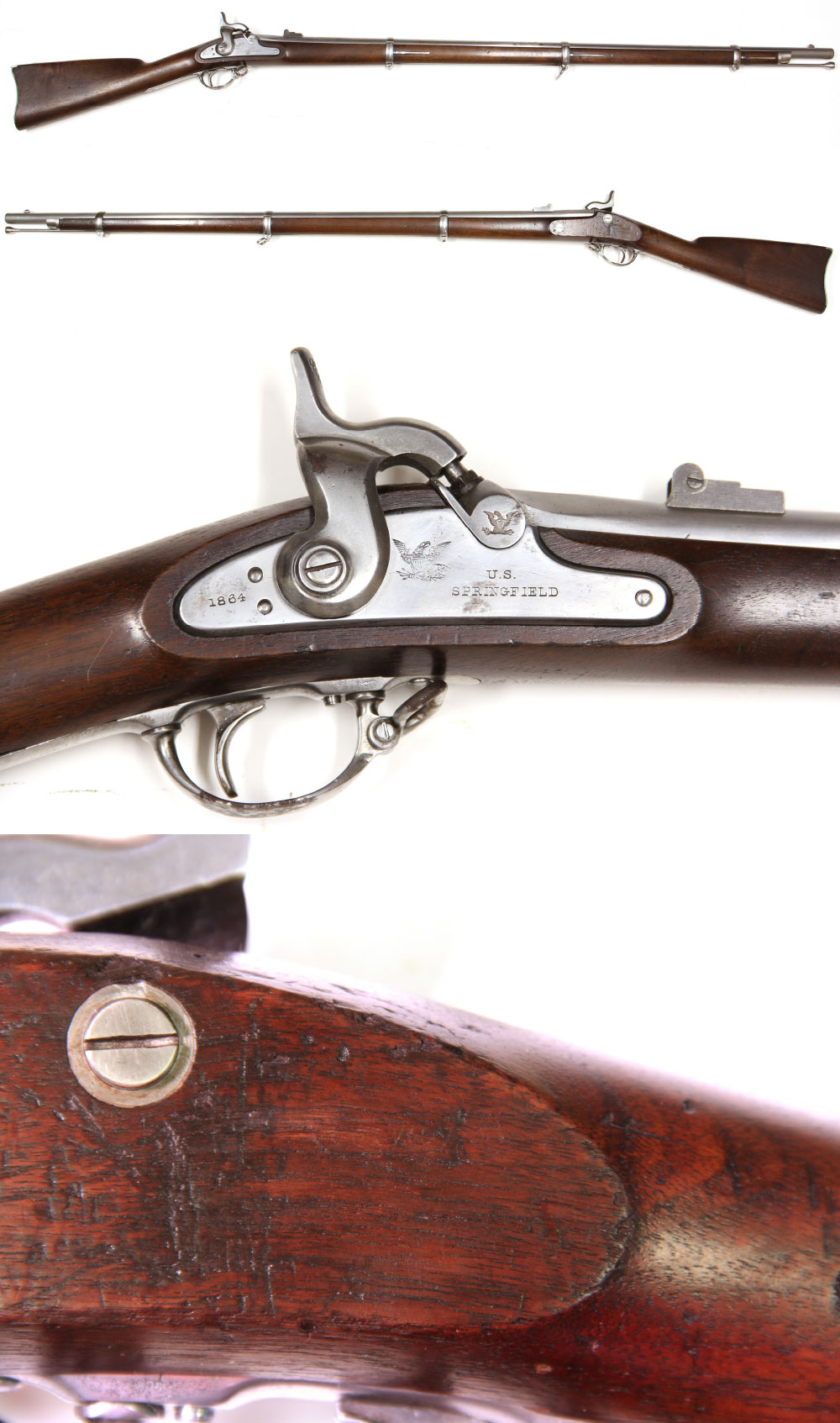
12-09-23 – Super Condition 1863 Type -2 Springfield Dated 1864:
Extra fine condition … correct “in the bright” finish. Just one minor gray spot on lower lockplate and right of bolster. Looks nearly like it did when first issued. 1864 on rear of lock, “US / Springfield” forward of hammer. Eagle on the lockplate and bolster, both sharp though the lock eagle is a tad light on the left. Sharp-edges on the wood, and very tight wood-to-metal fit, a few dings on the offside wrist, cartouches faint but present. Correct rear sight. This musket is standard “type-2” except having split screw “type-1” barrel bands. You could replace the top and bottom bands with readily available solid bands, but this musket surfaced with these type-1 bands in place and I am leaving it that way. The design for this gun was the result of improvements in the 1861 patterns and the 1861 “special models,” and became the standard US infantry arm from mid-war on. Again, one of the key pieces in a Civil War or US martial arms collection. It was the last percussion musket produced by the US government. Near mint bore and mechanically perfect.
$2,450.00 SOLD
Call us @ 419-842-1863


12-09-24 – Confederate P1853 Enfield Rifle-Musket w/ JC Cartouche and SH over G3 Marking
: The Enfield was issued in huge quantities to both northern and southern troops, imported in massive quantities by both sides, making the London and Birmingham arms makers a tidy profit. This one came through the blockade for the Confederacy. Nice “Tower/ 1862” marked lock plate, crown at rear. Good bolster and nipple. Rear sight firmly in place (these are sweat soldered in place and consequently are frequently missing from these guns.) Wood is very good, nice mellow color, just the usual scattered dings from actual use in the Civil War, and a scorched spot near the front barrel band. Most interesting markings are as follow … a small “JC” cartouche inside an oval border, stamped in the wood opposite the lock… And also a tiny “crown” over “SH” over “G3” in front of the butt plate tang. Once ludicrously attributed to Schuyler Hartley & Graham of NY, now believed most likely (and correctly) to be a variant on the Sinclair Hamilton marking. The standard Sinclair Hamilton marking is a tiny “crown” over “SH over “C” next to an “arrow”. Sinclair Hamilton was the English firm that supplied Enfields exclusively (or so it is believed) to the Confederacy. Metal has a pleasant smokey gray and plum patina. Has proper 25/25 barrel marks showing the gun is .577 caliber. Also bears a partial 2 letter inspector’s stamp at the breech, which is another feature found on blockade guns. Bore has good rifling showing expected wear. Tight metal/wood fit. All bands, swivels, brass nosecap, rod, etc. in place. These were the guns imported in the largest numbers and a common sight in the ranks of Confederate troops. For a Confederate display you cannot find a more affordable and proper musket. All original and mechanically perfect. An identical example with the same markings brought $2,875.00 at the James Julia auction in October 2010. Mine is Very reasonably priced at…
$2,150.00 SOLD
Call us @ 419-842-1863
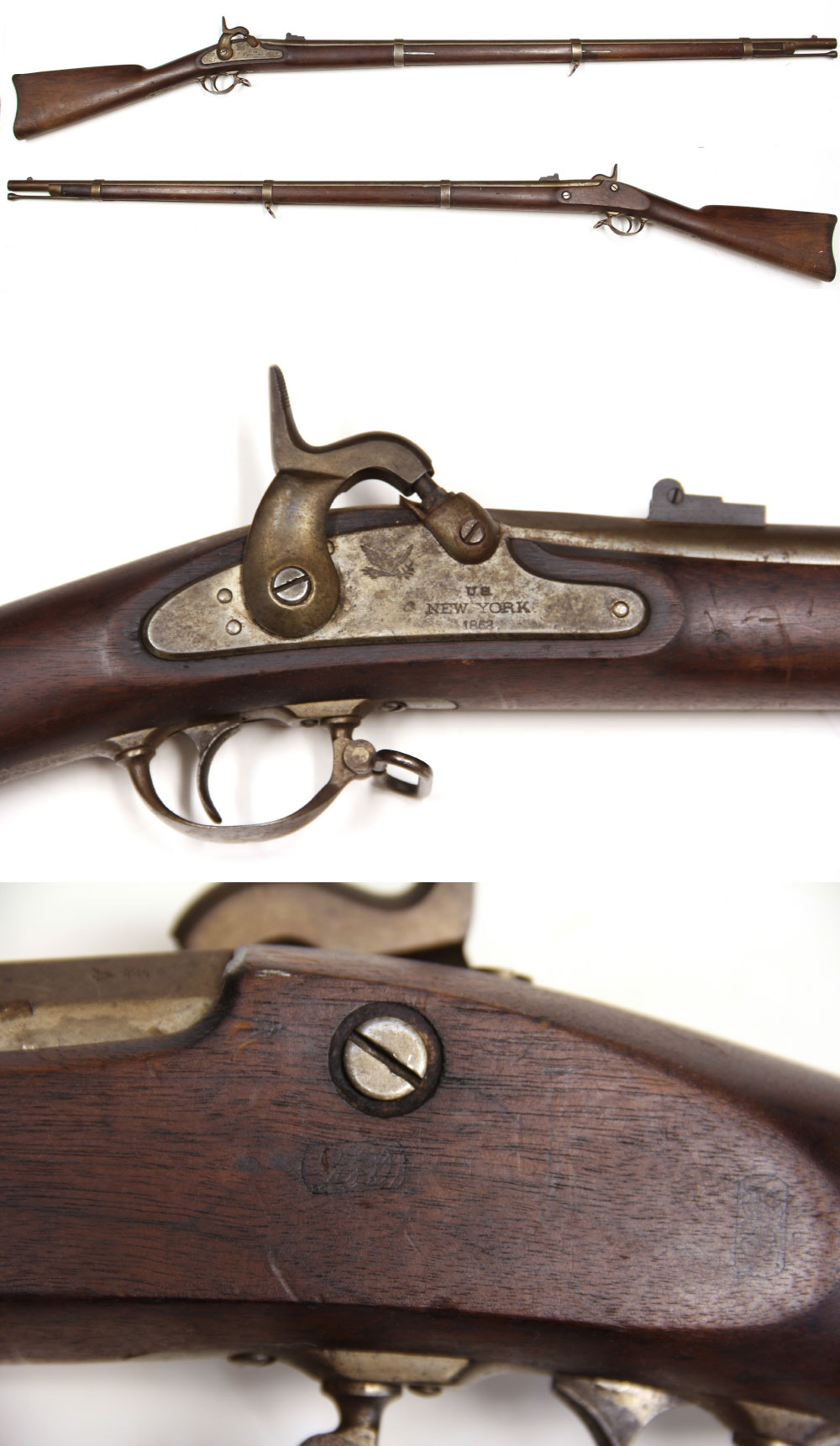
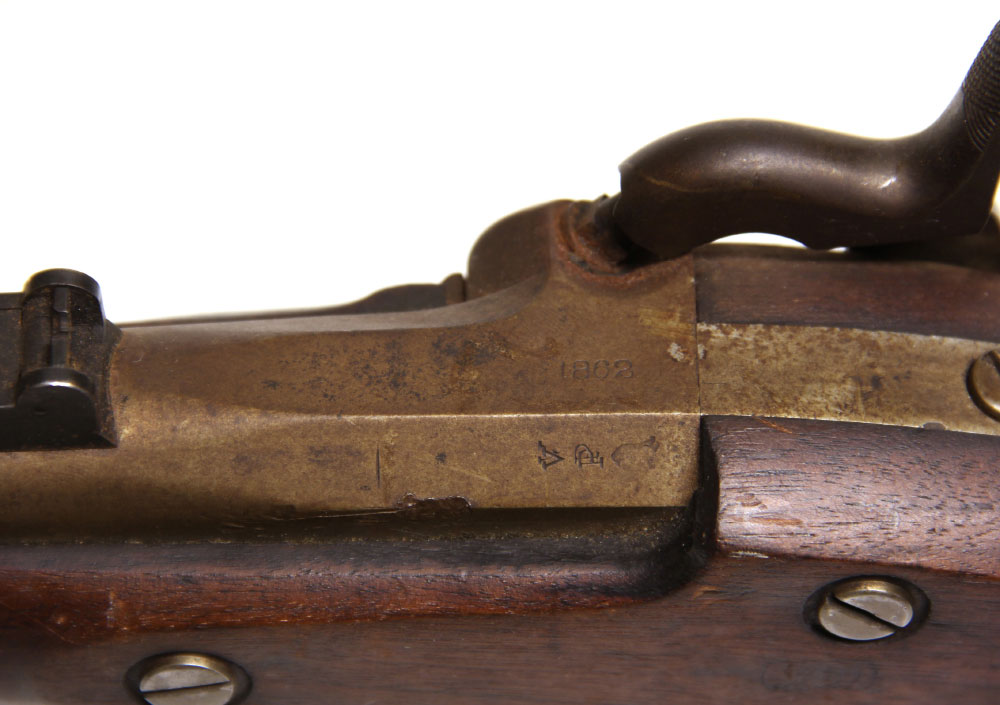
12-09-25 – Very Scarce Sarson and Roberts contract 1861 Pattern Rifle:
Musket aka the “New York” Contract. Only 5,140 made and very few of those survive in strong condition. With Springfield unable to keep up with demand, the government let a number of contracts to private manufacturers to make these M1861 muskets. Contract muskets are a collecting field in themselves, with this New York contract being one of the hardest to locate in original form and with strong condition. Correct S&R “Eagle / U.S. /New York /1862” marked lock plate. Attic untouched fine+ condition. Rear sight has lots of color. Balance of metal is bright shading to brown. Has that wood and cigar smoke patina from hanging on a den wall for decades. Very slight rounding to the wood back of the lock, but a very clear cartouche on the flat opposite the lock. Extremely fine condition. 100% original and complete, mechanically perfect… a darn fine example of a very scarce Union Army musket. Wonderful condition….
$2,895.00
Call us @ 419-842-1863
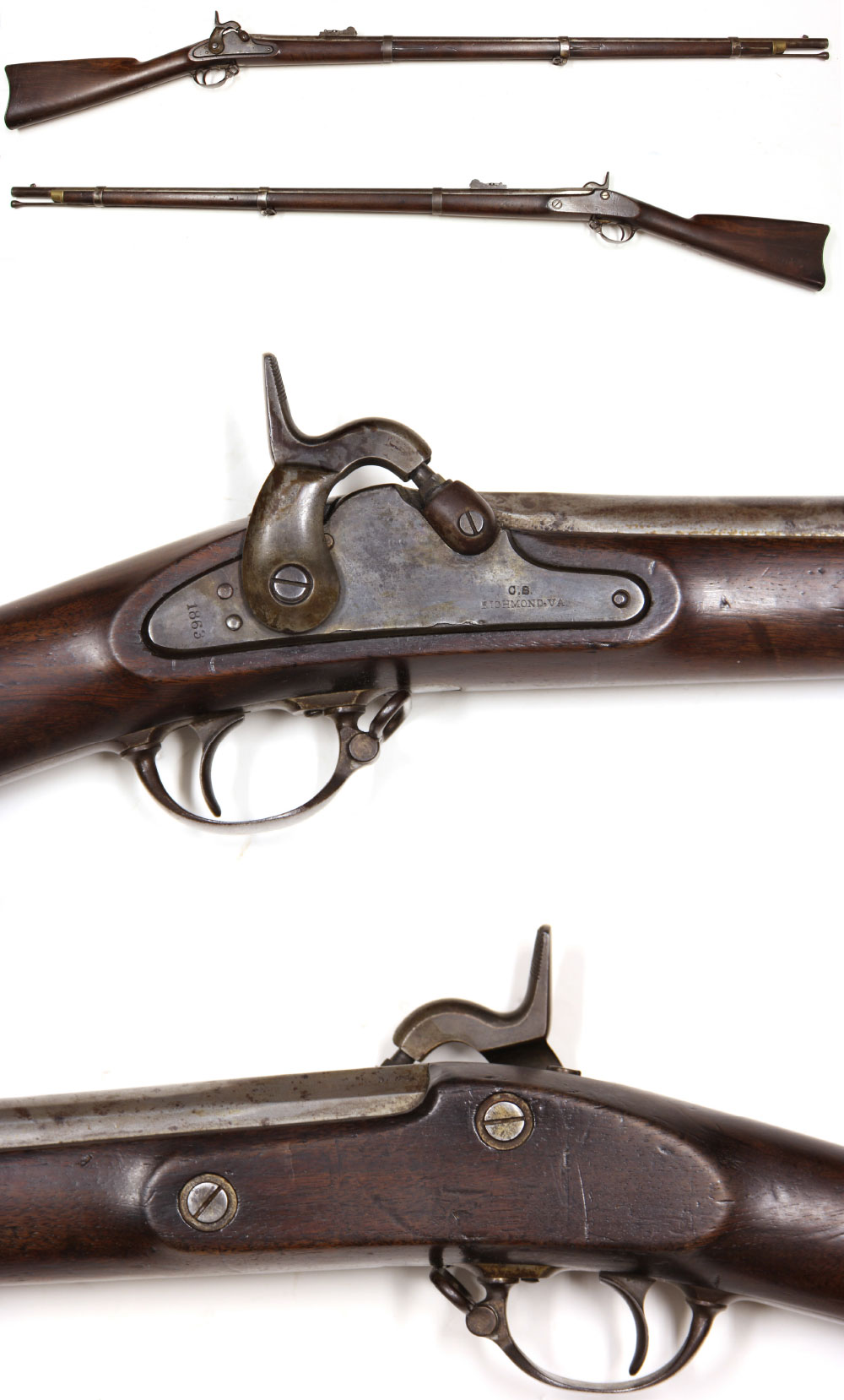
12-09-26 – Model 1855 / CS Richmond Rifle Musket
likely carried by a soldier in the 7th Florida. I obtained this musket at our Ohio Gun Collector’s Association meeting along with a classic Confederate made cap box that was beautifully incised on the front cover “John Jack/son Co K 7th FLA.” The seller had brought both pieces to the show on behalf of a friend who had owned both pieces for years and wished to dispose of them. I asked the seller if he would please ask the original owner if he had gotten both pieces together, and let me know the answer. Unfortunately I never received a response. I sold the cap box to a friend and advanced Confederate collector in Florida. Though there is no iron clad proof that this musket was carried by soldier Jackson, in my opinion it was very likely carried by him. The gun is a standard Springfield US Model 1855 type-1 rifle musket with an 1863 dated Richmond lock. Every part on the gun except the lock is US M1855. It has the long range rear sight, steel butt plate, brass nose cap, swelled ram rod, etc. Overall condition is Very Good+++. The lock is a wonderful CS Richmond 1863 example in exactly the same condition as the rest of the gun. The barrel is clearly dated 1858. All markings and proofs are vivid. No cartouche is visible on the stock. I paid far less for the gun than what it is worth were I to strip it and sell the loose parts separately. If you wanted to replace the lock with a Springfield Maynard tape lock you could sell the musket for $3500 and then sell the loose Confederate lock for $2000. I do not recommend this but make the observation for valuation purposes. I am certain the gun was carried in the Civil War exactly as it now stands. And I believe it was likely carried in the 7th Florida Infantry. Here is one of the more interesting Civil War long arms I have found in recent memory.
$4,500.00 SOLD
Call us @ 419-842-1863

12-09-27 – A Real ’61 Springfield:
The real deal … an 1862 Dated M1861 Springfield Rifle-Musket, the standard Union Army shoulder weapon of the Civil War. Has matched 1862 dates on lock and barrel. Clear barrel proofs, correct type-II rear sight. All barrel bands, sling swivels, ramrod, etc… all original and correct. Nice tight wood to metal fit, strong wood edges, screws not buggered up. Good nipple, good visible proper cartouches ESA and sub. Some light salt-and-peppering on the hammer and barrel near the breech showing honest war time use. Nice dark patina, very attractive, as found attic patina. This is the basic building block of any Civil War or US martial arms collection with a very hard to find early war date. A great REAL M1861 Springfield.
$2,250.00 SOLD
Call us @ 419-842-1863
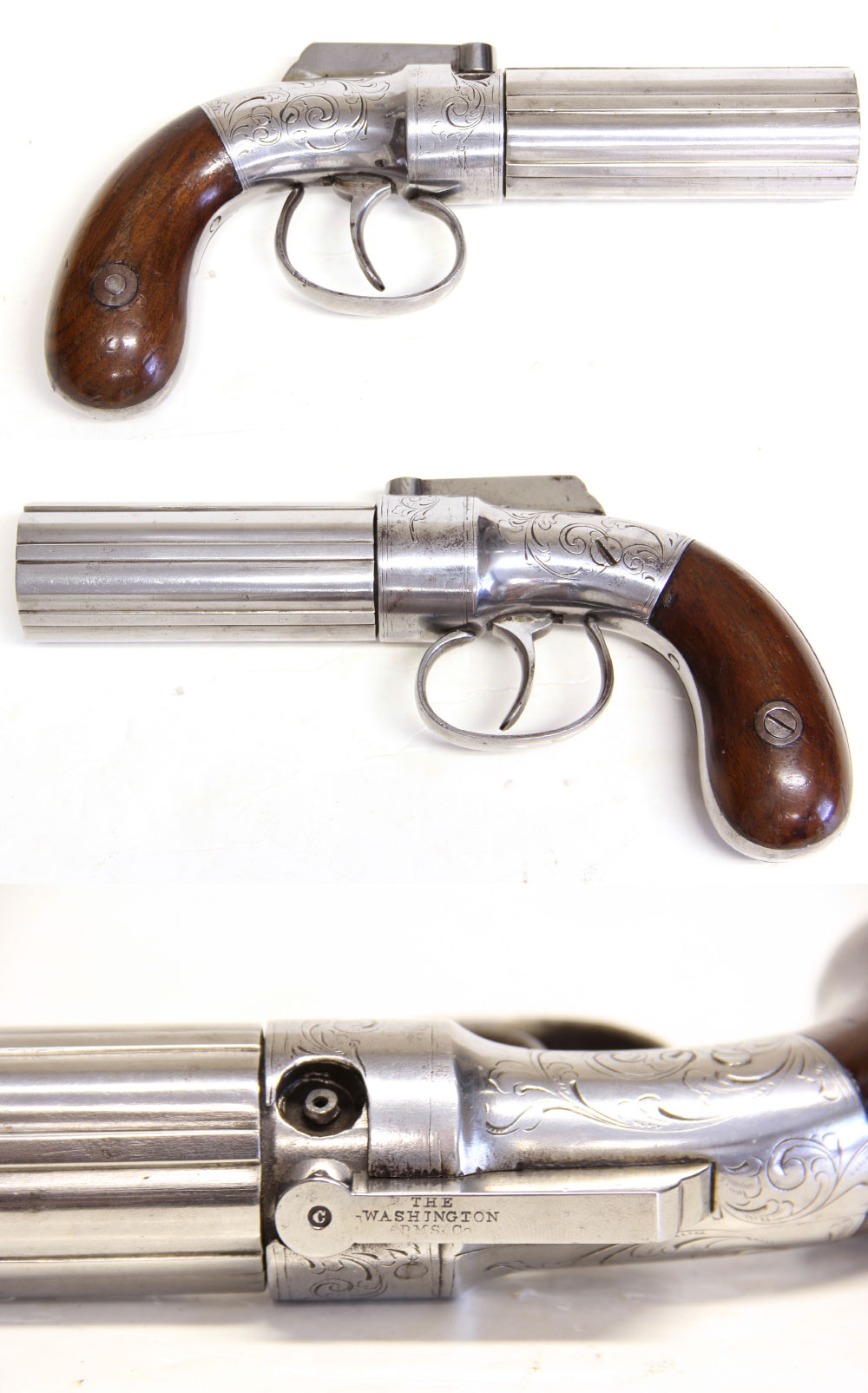
12-09-28 – Excellent condition 1850s double action pepperbox
revolver by William W. Marston, marketed under one of his trade names: “The Washington Arms Company” which is stamped into the spring action bar-hammer. A very nice condition gun that has been polished to an attractive bright luster. Has clear marks and engraving that would show off great in an American pistol or early west collection. .31 cal. six-shooter with floral engraving on the frame and an excellent walnut “bag” shaped grip. A higher grade, gentleman’s gun. These were much-carried guns by early travelers out west. Mark Twain recounts one of his companions carrying one in “Roughing It.” A small “C” on the hammer may be meant to convey “cast steel,” which Marston used on other versions of this pistol. You can’t find a pistol much more emblematic of 1850s America and early stagecoach days…
$550.00 SOLD
Call us @ 419-842-1863
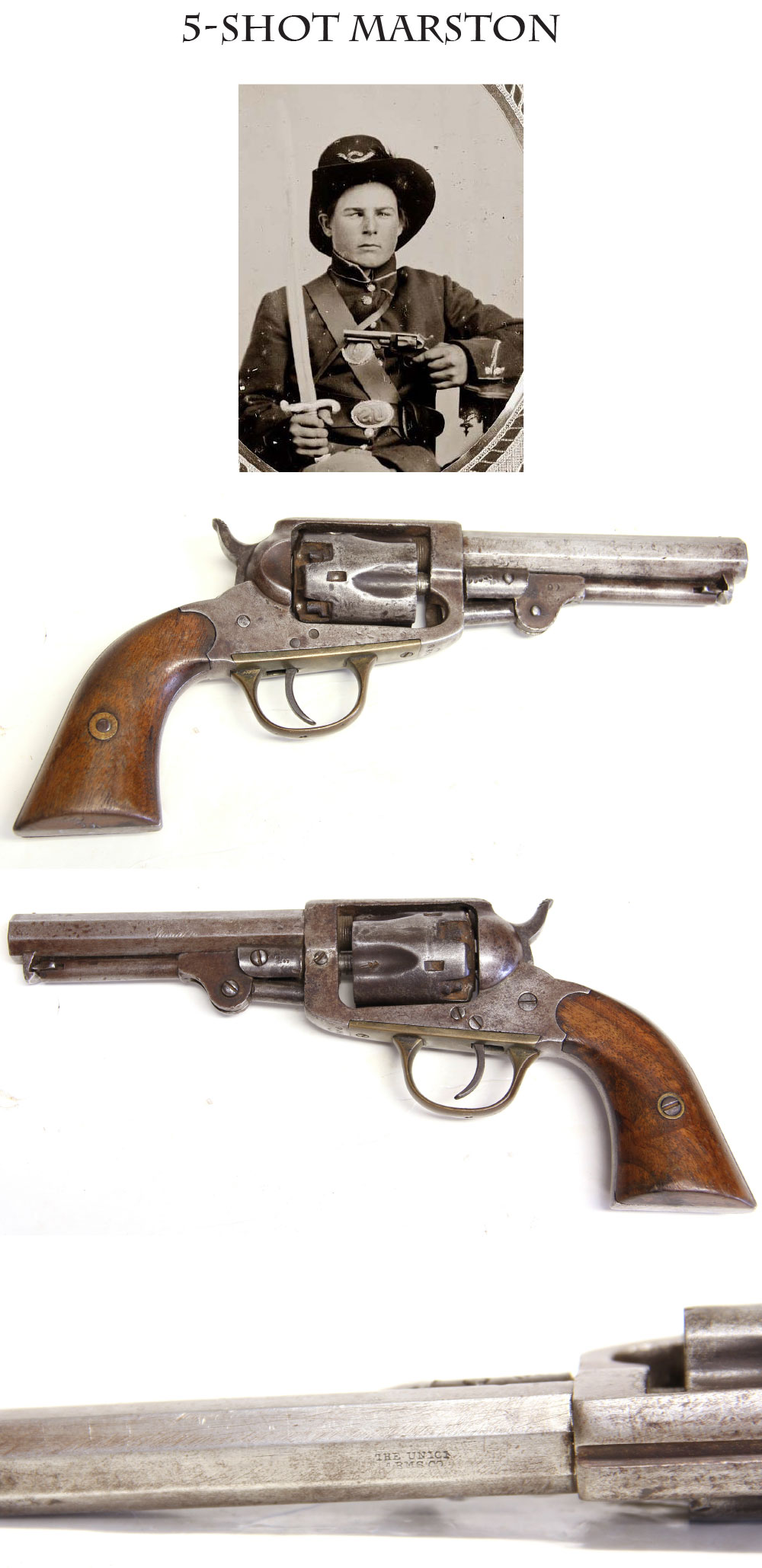
12-09-29 – Another W.W. Marston product
, this one signed “The Union Arms Co.” on the top flat of the octagon barrel. When some of Colt’s patents began to expire Marston and others got into the revolver market. Here is his fifth type pocket model revolver with 4.25 inch, 5-shot barrel and fluted cylinder. This one has excellent grips with a tight wood-to-metal fit. The metal is gray steel mixed with dark spots. Barrel marking legible, screw slots good, just the one on the frame showing any kind of turning and a couple of taps on the other side on the loading lever assembly. Some light brown coming up in the nipple recesses and a light crustiness on the nipples but they are good and not beat down. A very handsome Civil War revolver
$595.00 SOLD
Call us @ 419-842-1863
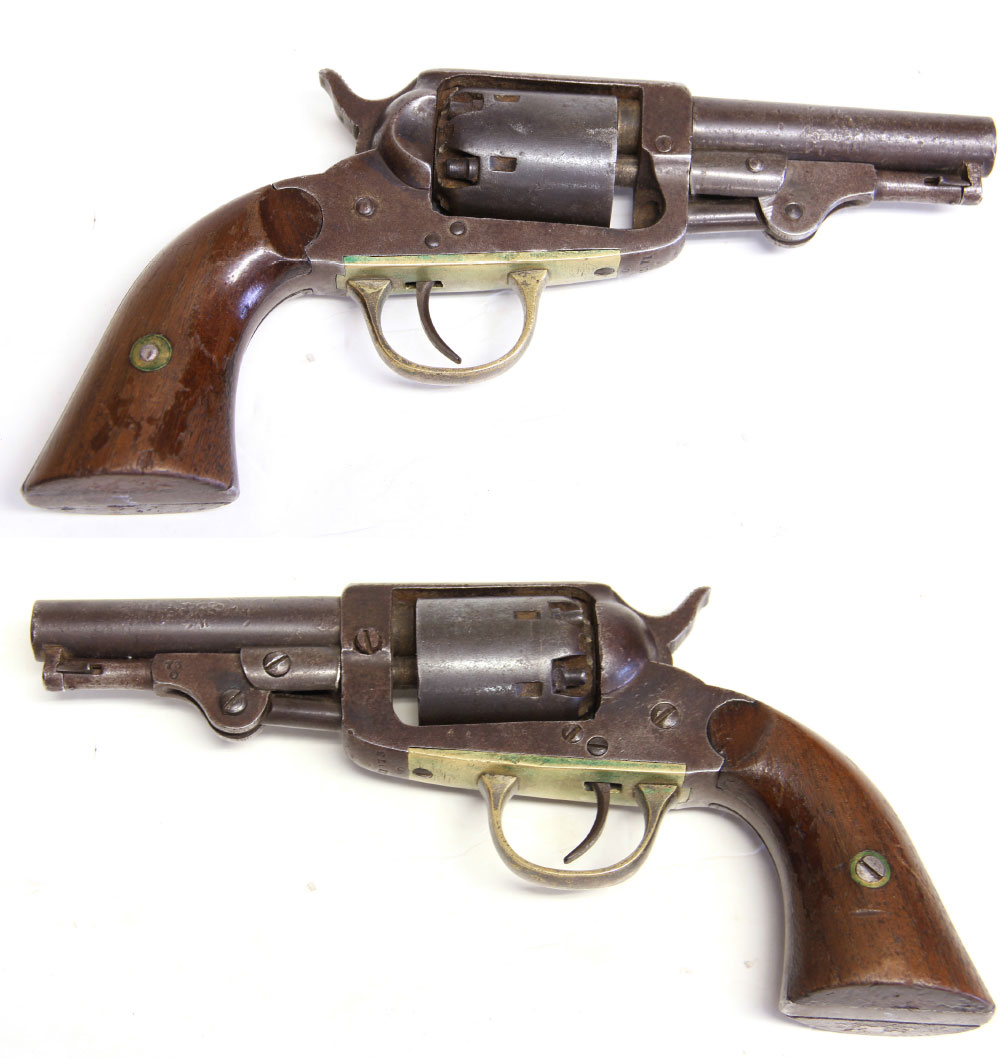
12-09-30 – Marston “Western Arms” 6-shot percussion pocket revolver.
Marston and others not only supplied dealers with appropriately firm marked guns, but also supplied guns marked with catchy trade names such as Union Arms, Western Arms, etc… This is the Seventh type, SN11073, 3.25 inch barrel, round cylinder. Grips good but some varnish loss. Front bead sight missing otherwise complete. Metal shows traces of blue in recessed areas. Overall faded blue with plum brown tones, very attractive. Some crustiness in the nipple recesses but the nipples are good and sharp, a couple of dings on either side of the barrel over the rammer hinge. A scarce pocket revolver and very nice condition.
$750.00 SOLD
Call us @ 419-842-1863

12-09-31 – Very nice condition Marston
“Union Arms” single shot percussion pistol. Top of barrel is stamped “The Union Arms Co.” Serial number *25 underside of octagonal-to-round barrel. Nice condition bag style grips. Slight push on bottom rear of triggerguard. Metal smooth with clear areas of faded blue. This style of pistol was very popular ca. 1850-60 as an easily concealed coat pistol useful for travelers and personal protection. Put this with an 1850s dirk and you are ready for some Mississippi riverboat gambling…
$350.00 SOLD
Call us @ 419-842-1863

12-09-32 – Bacon manufactured “Union Arms Co. N.Y.” 2nd Model revolver
, one line trade name on round barrel, .31 cal. 5-shot, 5-inch barrel, fluted cylinder SN 460. Bacon had worked for Manhattan Firearms and it shows. Nice floral, scroll engraving on the frame. Excellent grips with just a tiny piece out at the toe on one side. Overall smokey grey patina, minor dings on the cylinder, very pleasing overall… All original and mechanically fine.
$625.00 SOLD
Call us @ 419-842-1863
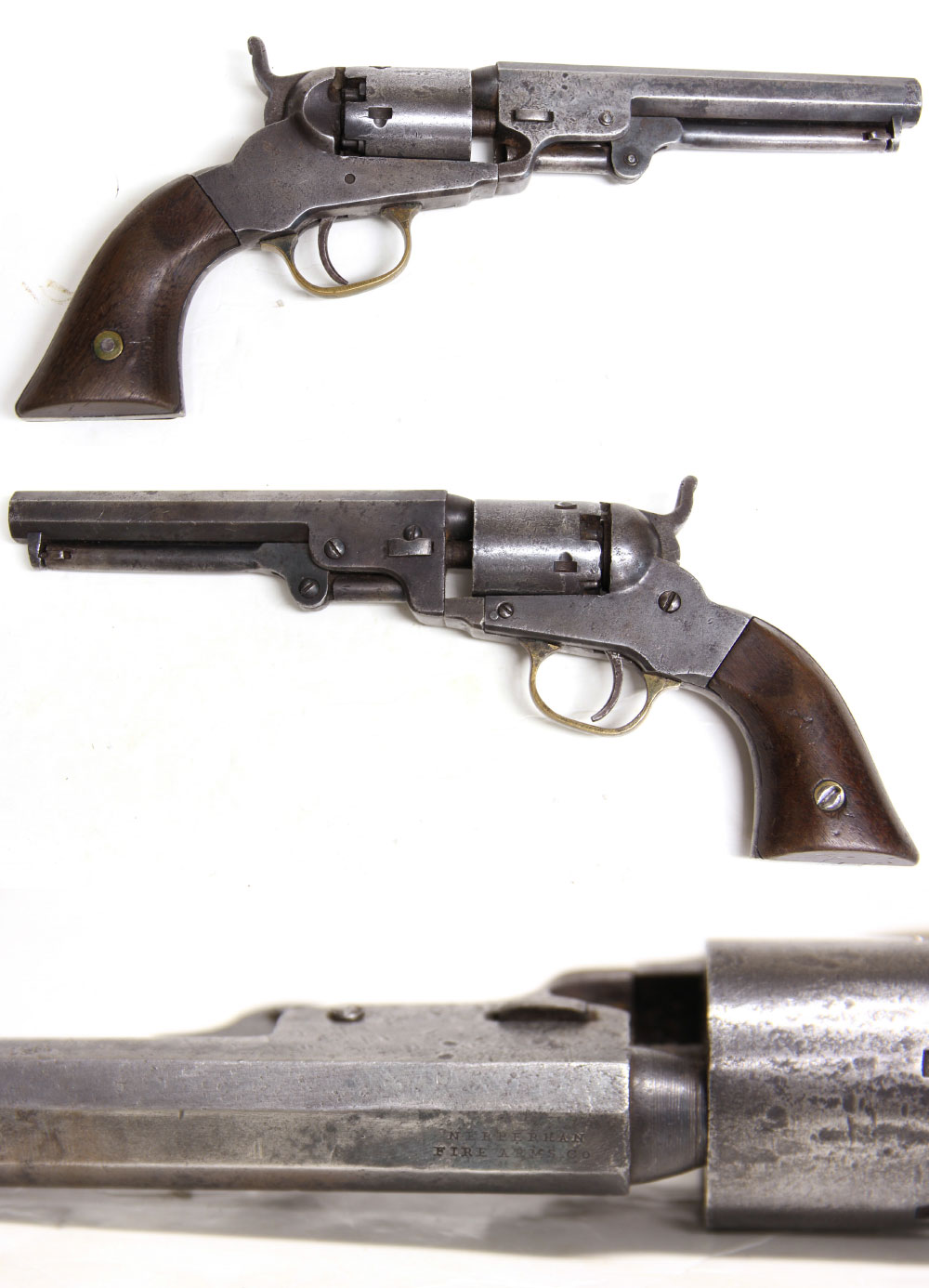
12-09-33 – Not everybody carried a Colt!
Nepperhan Firearms Company Revolver. Another company that tried to get into the revolver market in the late 1850s – early 1860s. Not a lot is known about this firm, but they made about 5,000 of these 5-shot .36 cal. percussion revolvers resembling Manhattans and Bacons in Yonkers, NY. Good grips with good fit. Grip screw slot shows wear. Some light salt-and-peppering to frame and cylinder, traces of blue on the 5.25 inch octagonal barrel. These guns played as much a part in winning the west as did the bigger companies with larger advertising budgets…. All original and mechanically fine.
$625.00 SOLD
Call us @ 419-842-1863
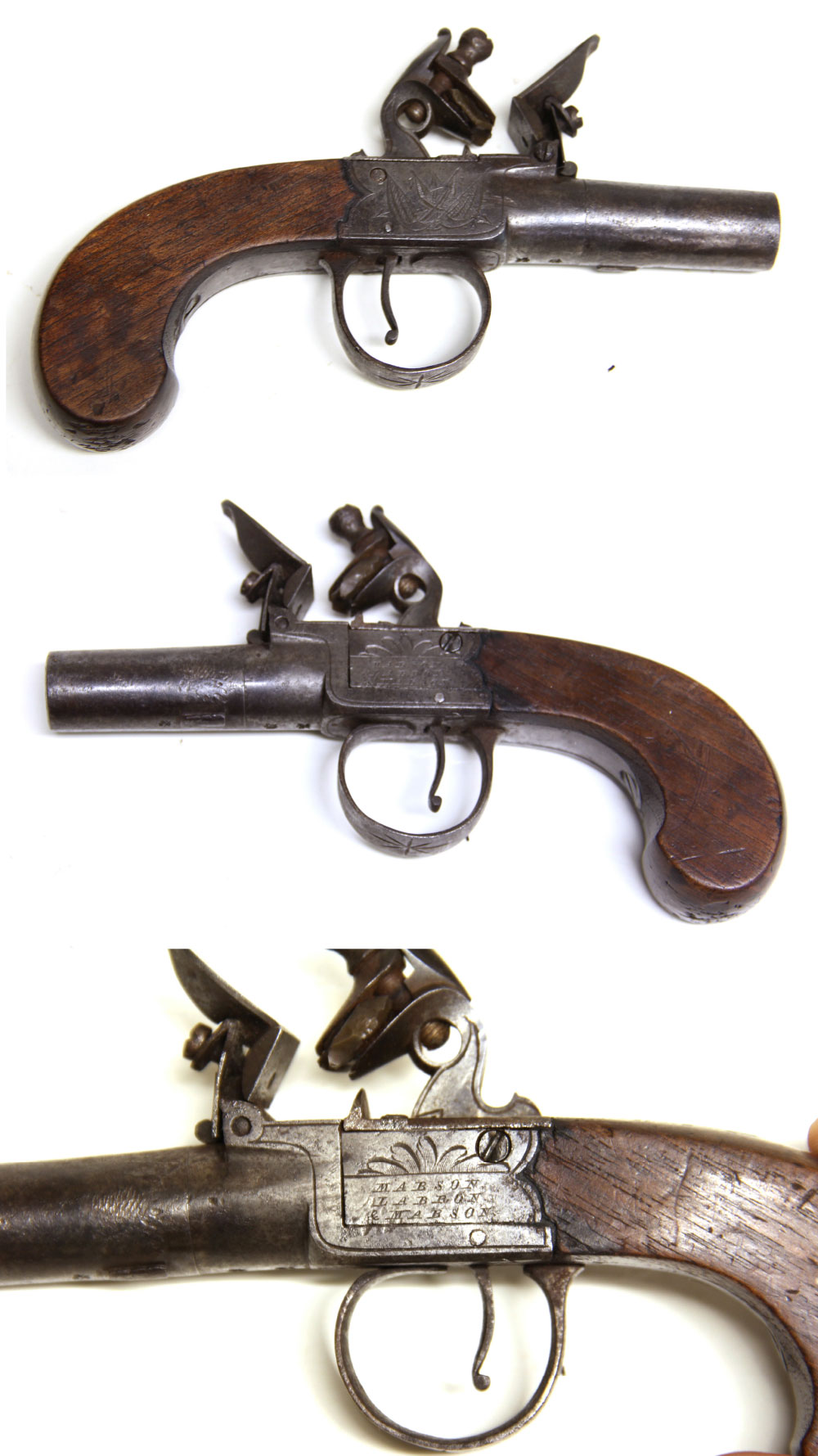
12-09-34 – Flintlock muff pistol
, 2.5 inch barrel, box lock, made in Birmingham. The engraved name “Mabson, Labron & Mabson” is from a firm of that name in Dunderdale, who were gun makers and ‘factors’, or traders. Because of the Birmingham proofs, it is possible that the gun was made for them rather than by them. Mabson & Labron are known circa 1821. I will assume that the additional Mabson is the son of the founder… hence dating this post 1821.
$595.00 SOLD
Call us @ 419-842-1863
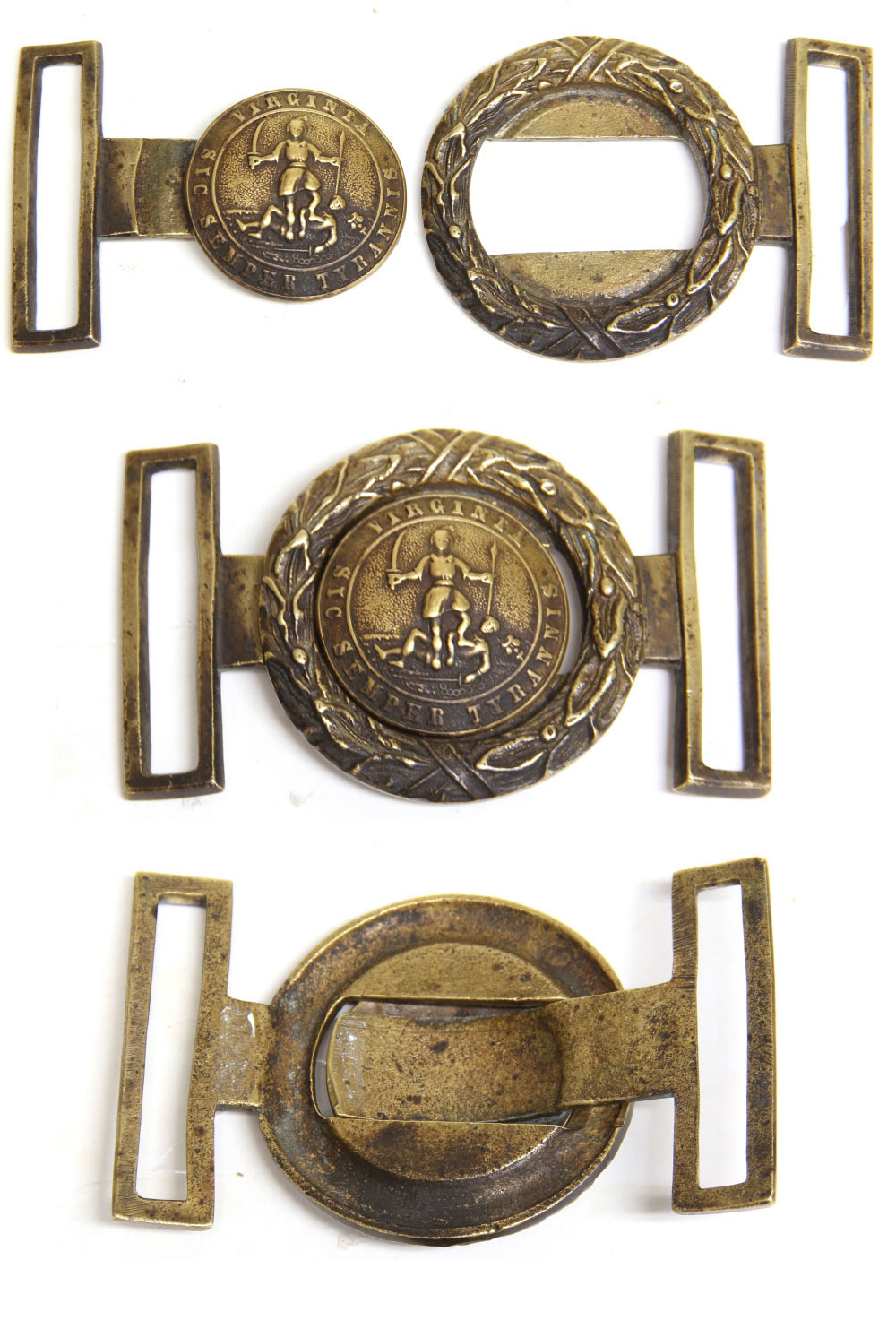
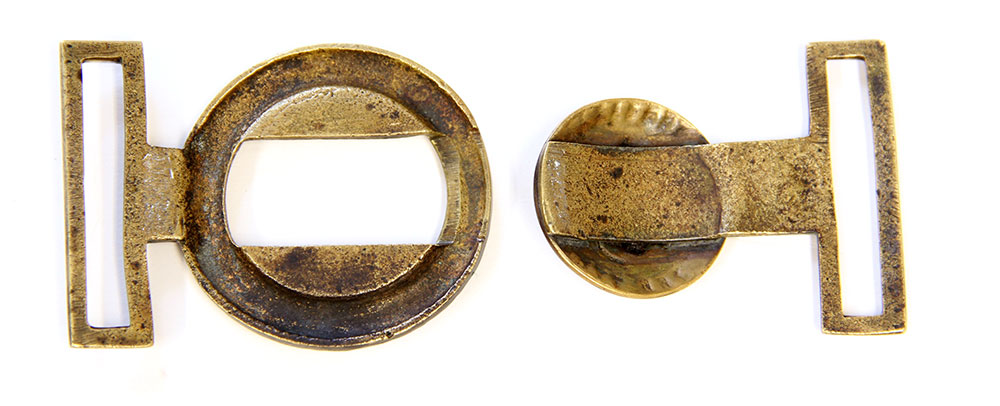

12-09-35 – Virginia Confederate Officer’s Buckle:
Very nice non-dug Virginia two-piece interlocking belt plate. See Mullinax (1991) plate 366. The tongue and keeper fit perfectly and have been together from Day One. The tongue disc is sweat-soldered to the retaining bar. The central state seal disc is a nice thick die struck planchet and not one of the thin militia sash buckles we occasionally see. A nice matching patina on both tongue and wreath, showing a tad darker along the lower half on both, with some rubbing on the top area. Virtue stands triumphant, sword in one hand and spear in the other, one foot on the vanquished oppressor and her broken shackles on the ground in the foreground, Virginia motto
Sic Semper Tyrannis
– “Thus Always to Tyrants” in the outer band of the tongue, entwined leaves, berries and ribband on the wreath. These two-piece interlocking plates are among my favorite designs. And it is nice to find a nice non-dug example once in a while as opposed to the dug relics. I just bought it last Sunday … Priced very friendly at…..
$2895.00 SOLD
Call us @ 419-842-1863

12-09-36 – Nice Honest Gwynn and Campbell Carbine
, sometimes called the “Grapevine” carbine from its serpentine loading lever. Also called a “Union” carbine of “Union Rifle” due to the frame markings. This is the Type II, about 4,000 made, .52 cal. Many units carried these guns: 7th Tennessee, 8th Ohio, 3rd Wisc., 5th Ill., and the list goes on. This is a sharp looking example, with steel grey metal surfaces showing evidence of light cleaning many years ago, … some graying here and there, grease still on it in some places, good legible 1862 patent markings behind the hammer, “Union Rifle” on the frame. Tight wood with good lines, just a few dings on the outboard side. This carbine shows every evidence of having actually been issued and used during the Civil War… Not like the hundreds of mint unissued examples of this model that abound.
$1,595.00 SOLD
Call us @ 419-842-1863
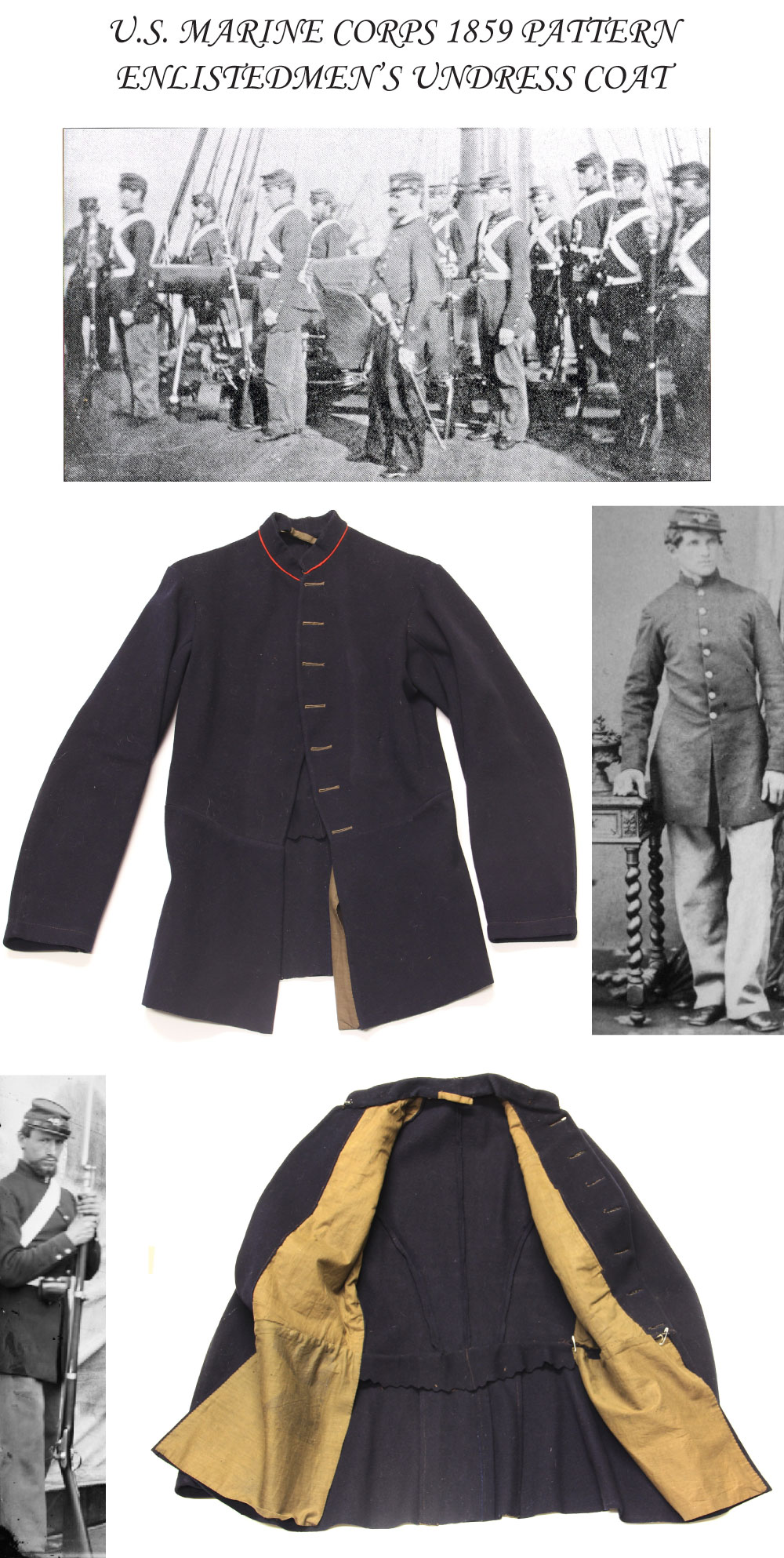
12-09-37 –
U.S. MARINE CORPS 1859 PATTERN ENLISTEDMEN’S UNDRESS COAT:
This coat was ordered by a good customer last month who sent a several thousand dollar deposit… and was going to pay it off in time payments. He then learned shortly thereafter that his family was going to be losing half their income and their health insurance. Needless to say, we wish him and his family “the best” in these trying economic times. And we are putting the coat back on the market.
This is a coat so rare that the vast majority of Civil War collectors do not even recognize it. Case in point, when this coat first surfaced it was offered at a prominent militaria and Civil War auction house and the “expert” auctioneer described it as some sort of a 19th century militia coat. I know of only three examples extant, (including this), and one of them is the usually published sergeant’s coat that does not follow regulations. This one does. The unpadded, fitted torso and short skirts can fool even a sophisticated textile collector into thinking they are looking at a later period uniform, but the USMC led the way in tailoring in their 1859 regulations and produced a shorter coat for field wear that was visually distinct from the army’s frock and sack coats.
Developed in 1859 as an intermediate uniform between full dress and fatigue garb, the undress coat was worn for tasks between formal dress parades on one hand and fatigue duties on the other. Though sometimes referred to as a “fatigue coat,” the 1859 enlisted undress coat was the real battle jacket, and evolved over the years into the current USMC enlisted dress uniform we know today.
With pre-war and post-war Marine establishments of under 2,000 men, and a wartime strength less than 4,000, any Civil War U.S. Marine uniform is rare.
Worn only from 1859 to 1875, the coat followed the pattern seen here: a low collar trimmed with a red welt along the base only; seven large buttons on the front and two on the rear at the waist; and two small buttons on each cuff. The skirts were made shorter than the army enlisted dress coat, officers’ frock coats, and those on the Marine enlisted full dress coat, extending only “from the top of the hip to the crotch of the trousers,” (1859 Regulations). Precisely what we see here.
The internal lining is like the full dress coat, brown polished cotton in the front and sides of the torso and the back of the skirts, and white linings in the sleeves.
As with the full dress coat, and unlike the army version, there are no pockets in the tails. Marines were intended to take part only in shipboard engagements, defense of posts, or limited landing operations. Hence you don’t see many Civil War Marines with gun slings or knapsacks. Wartime demands, of course, meant wider service. There was even a USMC battalion at First Bull Run, and they took part in many engagements right through the assault on Fort Fisher in 1865.
Shown here are three wartime photos of leathernecks wearing this coat.
There are three war date USMC buttons present. Additional war date examples can be had at some expense, or you can buy similar later examples for display purposes for a nominal cost. Condition is excellent save for a couple very minor blemishes. There is one tiny area of moth tracking on the lower breast that is hardly noticeable, and a couple lines of stitching that have given way on the collar hanging tab, one skirt panel, and part of the sleeve lining. No material is missing. The skirt panel is secured now with two pins to keep it from pulling out the rest of the stitching.
Far rarer than a Confederate jacket, and rarer than virtually all US cloth except for the enlisted Engineer’s coat. I can guarantee you will not find another available for purchase anywhere. This is the first and only 1859 USMC Undress Coat we have handled in over forty years of collecting and dealing. In fact I have owned only one other 1859 Marine coat in my lifetime… that being the 1859 Dress Tunic I found and catalogued several years ago. An incredibly rare and desirable coat: So rare even the USMC museum does not have one.
$13,500.00
Layaways are Welcome
Need to split your order into multiple payments? No problem! A simple 20% earnest money deposit will hold your item for you.-acf
You can then pay it off in easy installments that fit your budget.
Read Terms Here
Items to Sell? Contact Us
I am always interested in buying ANYTHING from the American Civil War… Guns, Swords, Civil War Muskets, Knives, Uniforms, Flags, Medals, Badges, Diaries, Letters, Autographs, Buttons, photographs, tintypes, daguerreotypes, Insignia, Camp Items, Battlefield Relics, canteens, Drums, Etc… Call 419-842-1863 and ask for Dave Taylor.

